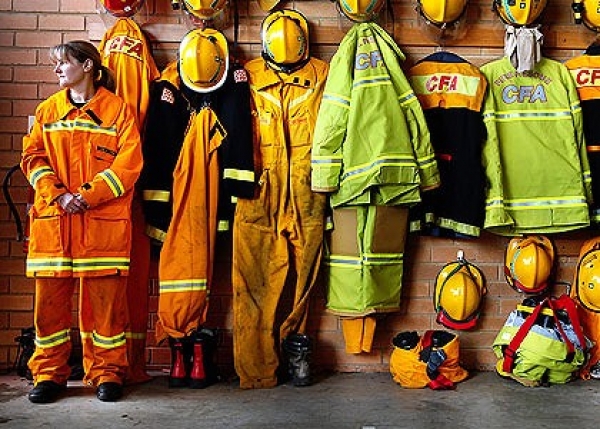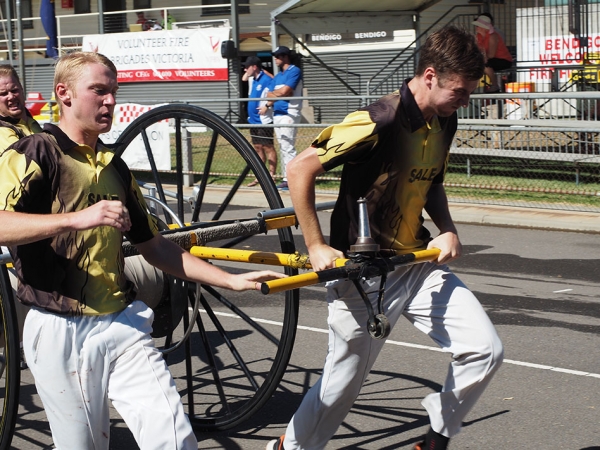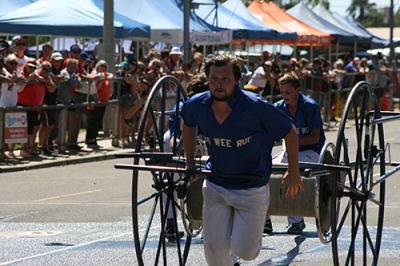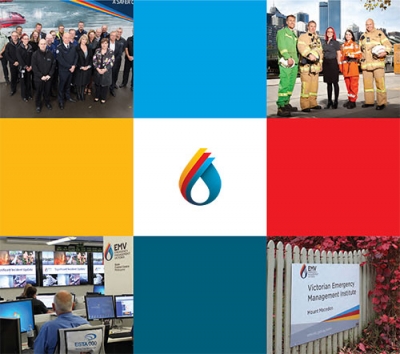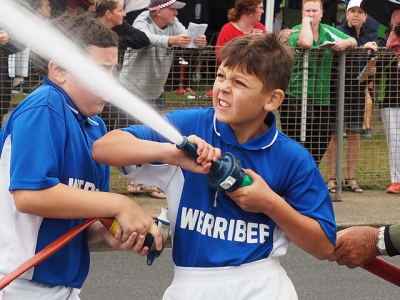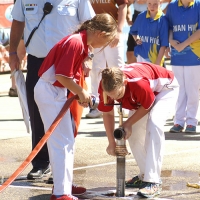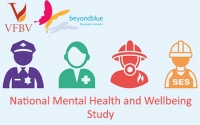
HomePage Featured (462)
Government Fire Services Reform Legislation Update
Written by Adam BarnettNOTE TO MEMBERS – 28th March 2018
GOVERNMENT FIRE SERVICES REFORM LEGISLATION UPDATE
SUMMARY
This is a brief note to provide an initial update regarding developments in the Victorian Parliament Upper House yesterday specifically relating to the Governments proposed fire services restructure and presumptive legislation Bill.
The legislation was considered by the Upper House yesterday along with some ineffectual amendments tabled at the last minute. Beyond the fundamental concerns about the legislation, the Government received strong criticism about the last-minute tabling of these amendments, the lack of briefing prior to them being tabled in the Upper House and the sudden haste to push the legislation through whilst parts of Victoria and many volunteers have been involved in major fire events.
Seizing on the absence due to illness of one MP who has indicated she does not support the legislation, the Government used its numbers to extend the sitting of the Upper House late into the evening. And due to the ill MP being hospitalized and unable to return to parliament yesterday the Government, with the support of the Greens and Reason Party MPs, was able to get the numbers to get a supporting vote through. The legislation was supported by one vote and has now passed the second reading stage.
The legislation was supported by one vote in an outcome that would have been totally different if the Government had followed standard practice of pairing a vote with the sick MP who had to urgently depart Parliament.
This is an alarming and very disappointing outcome and puts the future of CFA under serious doubt.
The legislation is scheduled to go back to the Victorian Upper House for further debate and questions tomorrow. If passed the legislation will bring an end to integration and the CFA as we know it.
BRIEF RECAP OF THE JOURNEY SO FAR
To recap, this proposed legislation change was announced by Premier Daniel Andrews and Minister James Merlino in May 2017 and subsequently received wide spread condemnation for being ill-conceived, driven by an industrial interference agenda, diminishing and discouraging volunteer capacity, dismantling the CFA integrated model and eroding the CFA Chief Officers power and control of CFA resources. Despite Government spin, the proposed legislative changes provide no additional service capacity or service interoperability than exists today and in fact the proposed changes further fragment the fire services. The Governments own messaging indicates the proposed change has been motivated by a Government and United Firefighters Union desire to find a way to push ahead with an over reaching EBA that limits how CFA supports, equips, recognises, respects and consults with volunteers.
The proposed legislation was introduced in May 2017 without consultation with volunteers, and without involvement of representatives from Emergency Management Victoria, the Country Fire Authority or the Metropolitan Fire Brigade.
Appallingly, the proposed legislation combines two totally separate issues, one being firefighters presumptive compensation rights for cancer illness caused by firefighting duties and the other being the proposed fire services restructure and arrangement changes that essentially carve up CFA, one as a ransom note for the other.
Based on concerns raised about the proposed legislation, including fundamental flaws and the lack of transparency underpinning its development, the legislation was referred to a Fire Services Bill Select Committee back in mid 2017. That Committee provided a detailed report in August 2017 making a number of key findings and recommendations (see attached), specifically including findings and recommendations completely opposite to the effect of the legislation now before parliament again yesterday.
Since August 2017 the proposed legislation has sat to the side-lines, well down the Upper House agenda list and not debated, no doubt because there has been strong indication from coalition and cross bench MPs that the legislation would not be supported if put to the vote.
OUTCOME FROM THE UPPER HOUSE YESTERDAY
The legislation was eventually put for debate in the Upper House yesterday. Appropriately, there has been much criticism about the disrespect this shows by the Government for the parts of Victoria still experiencing or recovering from the impact of major fires and the fact that volunteers from across Victoria have been heavily involved in major firefighting and recovery deployments.
As indicated above, the legislation was debated in the Upper House yesterday along with 29 pages of amendments that were apparently tabled to MPs yesterday. From a quick read, these amendments do not address concerns raised by VFBV including many concerns known to be shared by many senior officers within CFA.
Due to the volume of amendments and the late tabling of these there was a motion put to parliament yesterday for the debate to be adjourned for a day or two so that due consideration could be given. This motion was voted down by Labor, Greens and the Reason Party MPs.
Due to an illness and hospitalisation yesterday of one of the cross bench independent MPs, who has indicated she does not support the legislation, the Government was able to have the numbers to get a supporting vote through late last night.
VFBV understands that it is a long standing standard practice that when an MP from one side of an argument falls ill or cannot attend parliament sitting they will be paired with a corresponding MP from the other side of an argument, to keep the deliberations of parliament ‘fair play’. VFBV also understands that this request for a pairing was rejected by the Government yesterday.
The outcome is that by days end yesterday the Upper House voted on the second reading of the proposed legislation and the proposed legislation now progress to a committee phase and potentially final decision tomorrow.
There was then a motion put by the Victorian Shooters, Fishers and Farmers Party to split the Bill and appropriately separate the firefighters presumptive compensation rights for cancer illness aspects of the Bill from the proposed fire services restructure, allowing the presumptive compensation aspects to proceed. The motion to split the Bill, allowing presumptive rights aspects to proceed, was voted against by Labor, Greens and the Reason Party MPs. The motion was defeated by one vote.
NEXT STEPS
The legislation will now be considered by the Victorian Parliament Upper House again tomorrow with a process of MP’s working through the legislation in detail and an opportunity to ask questions, seek further amendments etc. Depending on progress of these discussions the legislation could be voted again tomorrow and either supported or rejected. If the legislation is voted and supported tomorrow without amendment, it will become law.
VFBV has already provided very detailed briefings to MPs about our concerns with this legislation and will continue to advocate these concerns today, tomorrow and beyond. Pending the outcome of tomorrows debate there will be further campaign action activated and further information will be provided to support and coordinate this.
Between now and the close of tomorrows debate volunteers are encouraged to re activate contact with your local MP and voice your views about the impact of the changes of the proposed legislation and also the foul play used to push this legislation through by seizing on the illness of an MP to rort the numbers and vote outcome.
LOOK AFTER YOURSELVES AND WATCH OUT FOR EACH OTHER
During these difficult times, it is extremely important that you look after yourself, and your fellow peers.
While emotions are running high, it is now more important than ever to support one another, and be kind to one another. Show compassion and empathy for those you interact with, and act with honour and respect. We would urge members not to resign, we joined to protect our communities, and our communities still rely on us. We will not be taking this lying down, and we will pursue this until the end.
This also a good opportunity to remind members of the following services available to all CFA members:
Emergency contacts
If your query is urgent, you should seek immediate assistance using one of the contacts below:
CFA Member assistance program
Access to psychologists and counsellors who can provide support to members and their families in managing the impacts on their psychological health and safety.
Phone 1300 795 711 (24 hours)
Lifeline
Lifeline provides crisis support 24 hours a day, 7 days a week.
Phone 13 11 14 (24 hours)
BeyondBlue Support Service
Access free, confidential support from a trained mental health professional.
Phone 1300 22 4636
Non-urgent contacts
There are a number of services available to members and their families to deal with non-urgent issues:
Member assistance program
Access to psychologists and counsellors who can provide support to members and their families in managing the impacts on their psychological health and safety.
Phone 1300 795 711 (24 hours)
Peer support program
CFA Peers are trained to provide Psychological First Aid following Potentially Traumatic Events, one on one support and links to other services for members and their families.
Phone your local Peer Coordinator. A complete listing of all peers by District can be found at; http://cfaonline.cfa.vic.gov.au/mycfa/Show?pageId=publicDisplayDoc&docId=017975
Chaplaincy program
Chaplains are allocated on a district basis. They provide pastoral care to members and their families including spiritual, physical, psychological and emotional care. Support is not limited to a faith.
Chaplains can also be contacted directly. Contact your local CFA office for more details.
Phone 1800 337 068 (24 hours)
* * *
Update 12/03/2018 1500: Final Results
Final results from the weekend can now be downloaded from the bottom of this page, under Attachments.
The 2018 Champion Competitor is Matt Royal, from Maryvale Fire Brigade. Jackson Dargaville & Jamie Hart both from Kangaroo Flat Fire Brigade came in equal second.
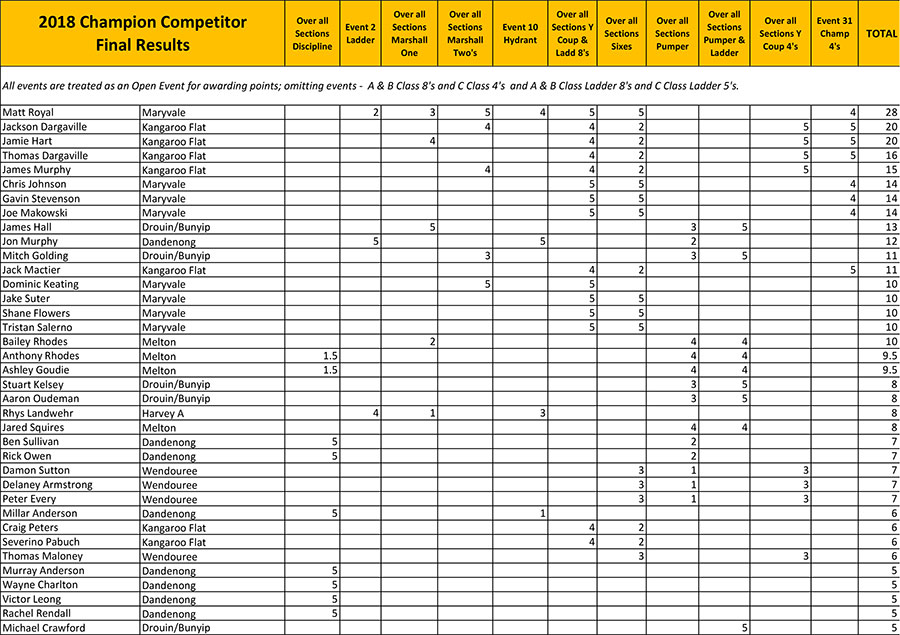
Update 12/03/2018 1330: Final Aggregate Results
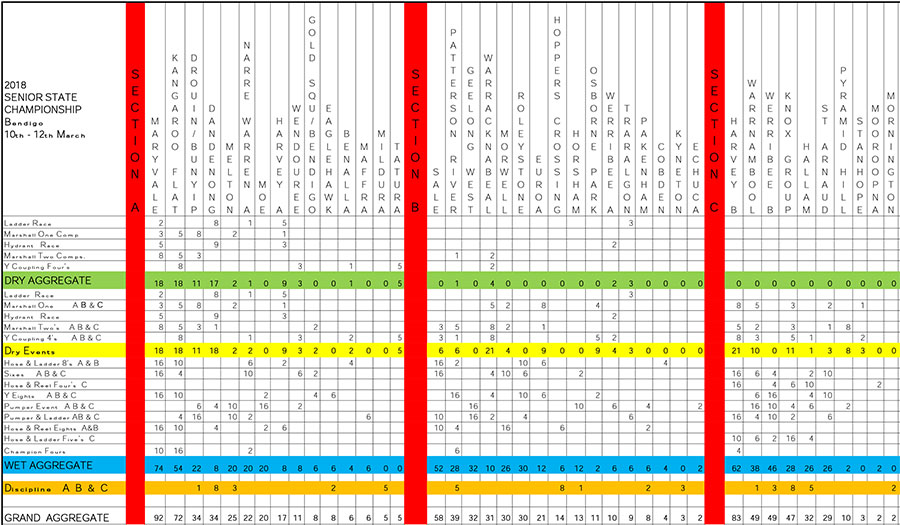
Update 12/03/2018 0800: Champion Competitor Interim Results (As at end of Day 2)
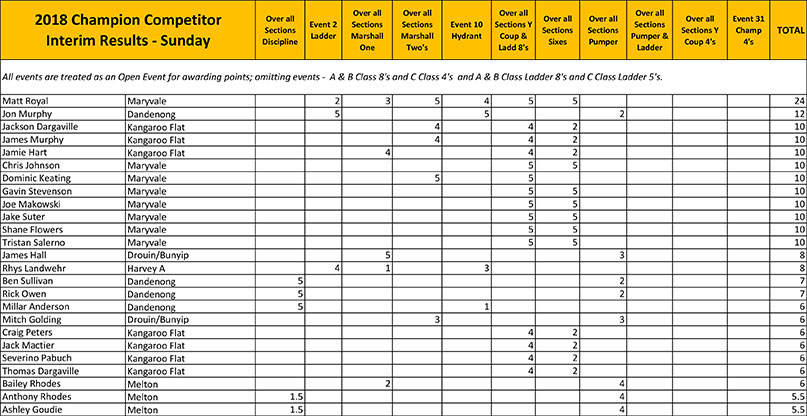
Update: End of Day 2 Results
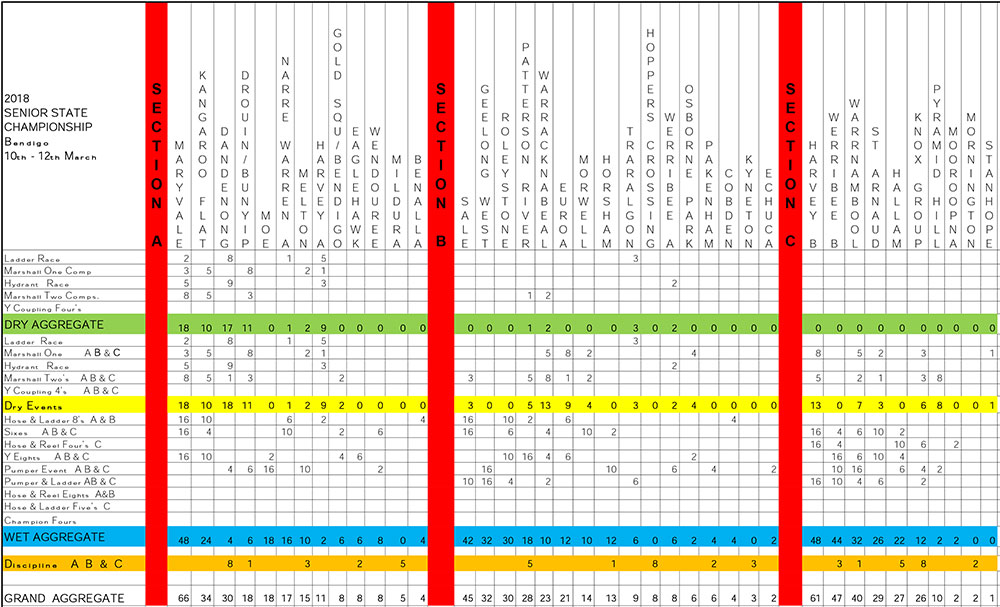
Results from this weekends State Senior Championships in Bendigo are being posted here: https://www.facebook.com/Volunteer-Fire-Brigades-Victoria-Championships-451309545285820/
You can also access a live photo feed from the weekend via our Flickr account found here: https://www.flickr.com/photos/vfbv/albums/72157691269033832
Aggregate Results - End of Day 1
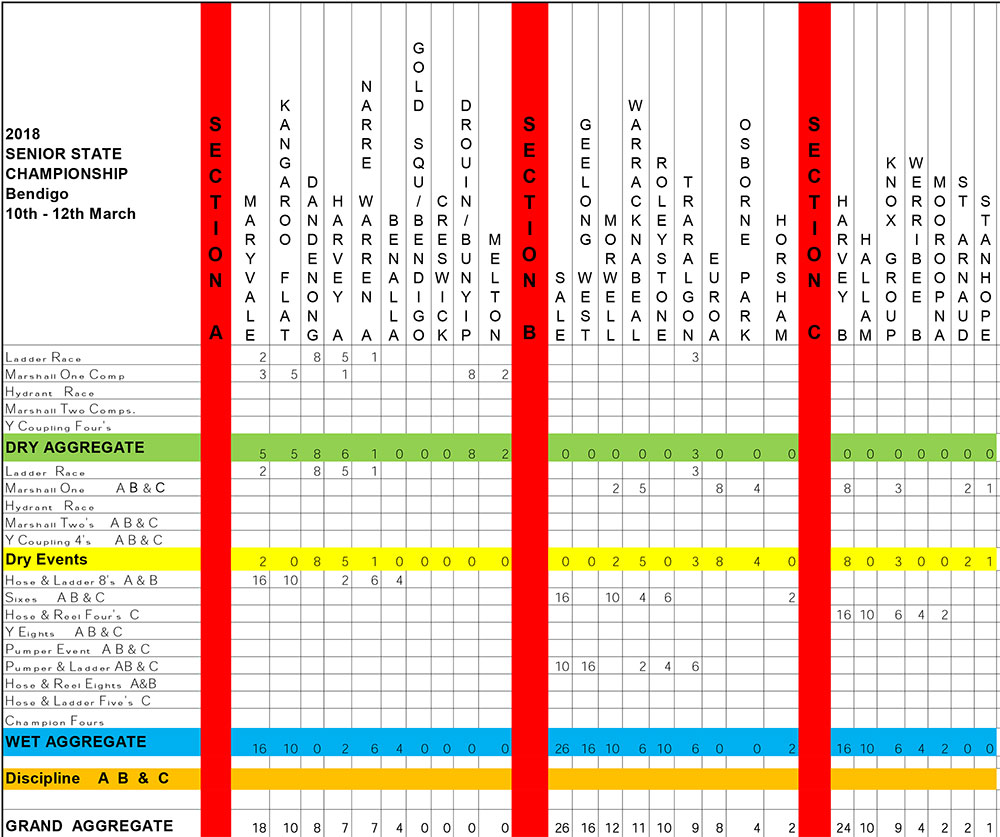
VFBV State Championships are one of Victoria's proudest and longest traditions, running for nearly 150 years with the first State Championship held in Melbourne in 1873.
Today, competitions and the State Championships remain an integral part of CFA activities and provide opportunities for many brigades across the State to come together to compete against each other in a range of events.
CFA is seeking to better understand the experiences of individuals in participating in championships and competitions which will help inform future initiatives to support the ongoing growth and sustainability of these events.
You are invited to complete a survey that CFA is conducting to share your experiences and provide valuable ideas and insights from the perspective of participants, officials and supporters. The survey will remain open until the end of April and all responses will remain confidential.
There will also be an opportunity to complete the survey and provide feedback at the upcoming State Championships. You can do this by visiting the ‘Championships – Have you say’ stand in the corporate marquee at the event during the following dates and times:
State Urban Championships – Bendigo
Saturday 10th and Sunday 11th March - 9am to 4.30 pm
State Rural Championships – Warrnambool
Saturday 7th April – 9am to 4.30pm
Sunday 8th April – 9am to 1pm
The survey can be completed online by following the link https://www.surveymonkey.com/r/championships1
If you would prefer to receive a paper copy of the survey you can request this by speaking to Raelene Williams on Ph: 0418 739 469 or email: This email address is being protected from spambots. You need JavaScript enabled to view it.
A reminder for everyone to consider getting along to the VFBV State Urban Senior Championships to be held at Bendigo this weekend (Saturday 10, Sunday 11, Monday 12th March).
The Bendigo and Districts Fire Brigades Championship Committee in partnership with the City of Greater Bendigo is again hosting the 2018 VFBV Urban State Championships in Bendigo this weekend.
This will be the 135th State Urban Championships, with this year attracting 49 Senior teams, including three teams from Western Australia.
Results from this weekends State Senior Championships will be posted here: https://www.facebook.com/Volunteer-Fire-Brigades-Victoria-Championships-451309545285820/
And we also be running our live stream of Photo's from the weekend via our Flickr account at; https://www.flickr.com/photos/vfbv/albums/with/72157693786197555
Emergency Management Legislation Amendment Bill 2018
Written by Adam BarnettNote to Members: Emergency Management Legislation Amendment Bill 2018
This note seeks to bring to your attention some legislative amendments currently before the Victorian Parliament seeking to amend amongst other things the Emergency Management Act 2013 and consequential amendments to the CFA Act 1958, which for the most part are restricted to aspects relating to Regional and Municipal Fire Prevention committees and planning.
At a fundamental level the proposed legislative amendment removes the Regional and Municipal Fire Prevention Committees from the CFA legislation shifting the powers, responsibilities and arrangements previously assigned to CFA to now come under the EM Bill and Emergency Management Victoria (EMV).
VFBV became aware in recent days that this amendment Bill has now been introduced for consideration to the Victorian Legislative Assembly (Lower House) by Minister Merlino last week by way of a first reading speech on the 20th Feb 2018. Debate on the amendments is expected to resume on the 7th March before then proceeding to the Upper House.
Historical Issues
Following the introduction of IFMP (Integrated Fire Management Planning), arrangements surrounding Regional and Municipal fire prevention committees has been a topic of discussion amongst volunteers, CFA and within communities for quite some time.
For many years volunteers have been raising concerns including;
- The weakening of formal local engagement between Brigades/Groups, CFA and the Municipal fire prevention committee’s
- A reduced focus on wider community engagement in the development of Municipal fire prevention plans
- changes in volunteer representation to the Committee’s, and changes to meeting times and days that sometimes hinder volunteer/community involvement
- A reduced focus on the coordination and planning of fire breaks, and strategic fuel reduction plans for areas located within the municipality (but not located on public land)
These concerns have been discussed at length following changes to the composition and process of Municipal Emergency Management Planning Committees since about 2014 and both CFA and VFBV have previously identified that these and several other issues should be considered in any future legislative arrangements.
It would appear these concerns and previous input may have been lost along the journey, as they do not appear to have been addressed in the proposed legislative changes.
Proposed Advocacy
Having reviewed the amendments now outlined in the proposed Bill and consistent with concerns previously raised by volunteers with regard to Municipal Fire Prevention Planning and Municipal Emergency Management Planning it is VFBV’s intent to continue to advocate for:
- Ensuring the regulation/enforcement, audit and quality control arrangements are adequate and not eroded;
- Strengthening of formal arrangements to support local Brigade/Group engagement
- Ensuring that there is sufficient prescription and legislatively backed requirement for Municipal Emergency Management Plans to identify fire risks and drive mitigation treatments to address and prioritize the reduction of fire risk including land use, and the construction of fire breaks and fuel reduction on private land/and road/rail corridors within the municipality (The proposed new arrangements are silent on these matters)
- Effective arrangements to support compliance and accountability for the treatment of risks identified
- Ensuring mandatory volunteer and community engagement/consultation and representation
Next Steps
The proposed legislation is still before the Victorian Parliament and will need to be considered by the Upper House before it can be adopted. Although timing is impossible to predict, given that the proposed Bill is already before the Lower House, further debate and deliberations are likely to be within the coming weeks.
Given that there has been a long gap between the initial introduction of IFMP arrangements and initial discussions about changes to Regional and Municipal fire prevention committees you are encouraged to revisit this issue amongst your local networks; stocktake how the current arrangements are working and/or how they could be strengthened; and provide feedback as a priority if there are other issues you wish to raise regarding the proposed legislation.
Although the amendment Bill is already before Parliament, VFBV will continue to explore opportunity for consideration for amendment to the Bill. You are encouraged to engage in conversation at local MP level to ensure volunteer issues are understood.
At the bottom of this page, you can download the following attachments:
- VFBV News Note
- The Emergency Management Legislation Amendment Bill 2018
- Part IV of the CFA Act which it is proposed by this legislation to be repealed
You can also access further reading by clicking on the following links:
Junior Championships Results Feed and Photos
Written by Adam BarnettUpdate 02 March 2018: Full results, including all team times have been posted here: http://www.vfbv.com.au/index.php/champs/urban/results
Results from this weekends State Junior Championships in Warrnambool are being posted here: https://www.facebook.com/Volunteer-Fire-Brigades-Victoria-Championships-451309545285820/
You can also access a live photo feed from our Flickr account found here: https://flic.kr/s/aHsmfXtoY4
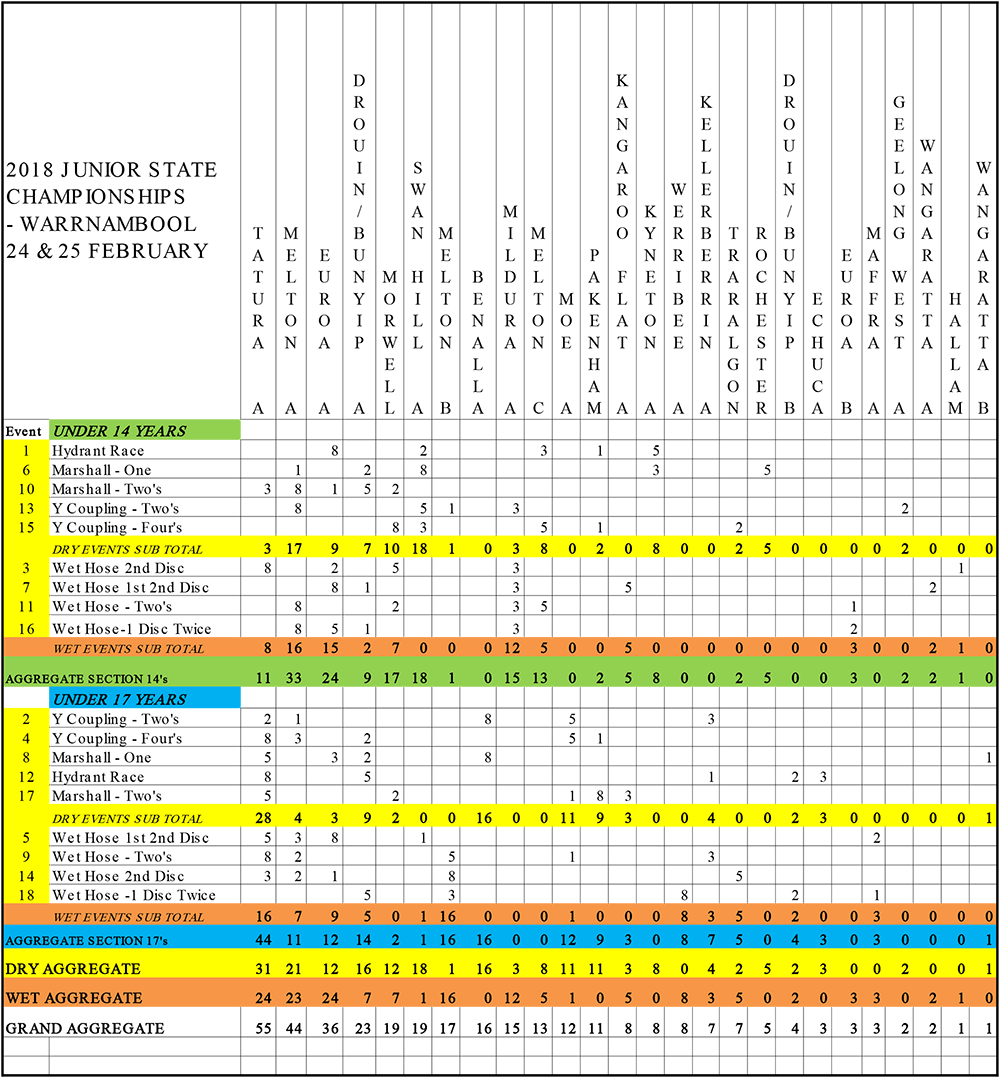
Final Results can be downloaded from the bottom of this page under Attachments.
VFBV State Junior Championships - This Weekend
Written by Adam BarnettA reminder for everyone to consider getting along to the VFBV State Urban Junior Championships to be held at Warrnambool this weekend (Saturday 24 and Sunday 25 February).
Come and see tomorrow’s CFA volunteers proudly demonstrate their skills and if you are not involved with the CFA juniors program or haven’t witnessed the value the VFBV Junior Championships provide for young volunteers to develop practical skills and to be actively involved in CFA then get along and be inspired.
This weekends Championships is being held at:
Friendly Societies Park
3350 Koroit Street
Warnambool
VicRoads Map 514 Ref G6
To learn more about the history of the Championships, please visit: http://www.vfbv.com.au/index.php/champs/championships/history
2018 VFBV State Urban Junior Championships
The Warrnambool Urban Fire Brigade is hosting the 2018 VFBV Urban Junior State Championships in Warrnambool, on 24/25 February 2018.
Urban junior fire brigade competitions have a proud 45-year history, with the annual State Championships attracting around 66 teams from across Victoria, and two teams as far away as Western Australia making 70 teams.
Program of Events
SATURDAY FEBRUARY 24th
COMMENCES AT 0830 HOURS
OFFICIALS TO REPORT IN AT 0815 HOURS
ROLL CALL OF BRIGADES (for Opening Parade) 0815 HOURS
OPENING PARADE - COMMENCES 0830 HOURS
0830 OFFICIAL OPENING
Event 1 Hydrant Race – One Competitor, Under 14 Years
Event 2 Y Coupling – Two Competitors, Under 17 Years
Event 3 Wet Hose Striking Second Disc – Four Competitors, Under 14 Years
Event 4 Y Coupling – Four Competitors, Under 17 Years
Event 5 Wet Hose Striking First & Second Discs – Four Competitors, Under 17 Years
Event 6 Marshall – One Competitor, Under 14 Years
Event 7 Wet Hose Striking First & Second Discs – Four Competitors, Under 14 Years
Event 8 Marshall – One Competitor, Under 17 Years
Event 9 Wet Hose – Two Competitors, Under 17 Years
Event 10 Marshall – Two Competitors, Under 14 Years
Event 11 Wet Hose – Two Competitors, Under 14 Years
SUNDAY FEBRUARY 25th
COMMENCES AT 0830 HOURS
OFFICIALS TO REPORT IN AT 0800 HOURS
ROLL CALL BRIGADES (for Events 12 & 13) AT 0815 HOURS
Event 12 Hydrant Race – One Competitor, Under 17 Years
Event 13 Y Coupling – Two Competitors, Under 14 Years
Event 14 Wet Hose Striking Second Disc – Four Competitors, Under 17 Years
Event 15 Y Coupling – Four Competitors, Under 14 Years
Event 16 Wet Hose Striking One Disc Twice – Four Competitors, Under 14 Years
Event 17 Marshall – Two Competitors, Under 17 Years
Event 18 Wet Hose Striking One Disc Twice – Four Competitors, Under 17 Years
Queensland Emergency Fire Service Superintendent Tim Watkins has opened up about his personal story.
He explains why mental health must be a focus in our workplaces, and he encourages anyone invited to participate in this groundbreaking survey to take the time to fill it out.
This is an opportunity for Australian emergency services personnel to again lead the world, not just in caring for communities, but in supporting themselves and their colleagues.
Reminder About the Survey
The world’s largest study on mental health across emergency services personnel is happening right here, right now.
Employees, volunteers and former employees from police, fire and rescue, ambulance and emergency services across Australia are being invited to participate in a short survey. In Victoria, VFBV has strongly advocated and supported CFA to be involved, and volunteers were sent invitations to participate on Friday 2nd February 2018. If you receive an invitation we encourage you to participate.
A representative random sample of CFA volunteers is being invited to participate in the survey. Participants have been selected at random and not on the basis of their wellbeing. This is to provide a representation of the needs of the whole police and emergency services sector. If you were randomly selected, you will have received an email at the email address recorded on CFA’s RMS system. For further information on the survey, please visit beyondblue.org.au/pesresearch and click on the ‘FAQs for participants’ link. You can also phone the research team on 1800 677 248 or email This email address is being protected from spambots. You need JavaScript enabled to view it.
Don’t miss out on having your say! Check your email to start the survey. Double check your SPAM or JUNK folders to see if you received it. The invitation were emailed on Friday 2nd February, and would have been sent from this address: (Beyond Blue PE Survey) This email address is being protected from spambots. You need JavaScript enabled to view it.
For further information, please click here to see a more detailed article.
I haven't received a link but want to be involved?
If you haven't received a link, but want to be involved, you can contact the research team at Roy Morgan, and they can provide you details on how you can participate. You can contact them by emailing: This email address is being protected from spambots. You need JavaScript enabled to view it.

Queensland Emergency Fire Service Superintendent Tim Watkins has opened up about his personal story.
TIM WATKINS: survey is time well spent for two reasons
No emergency services worker deserves to experience what Tim Watkins has been through.
The Queensland Emergency Fire Services Superintendent returned to work in Brisbane just months ago after almost two years dealing with post-traumatic stress disorder.
The condition was triggered by two emergency response events involving road fatalities in the early 1990s.
It took years for the after effects to manifest.
Physically and emotionally drained, Supt Watkins began taking consecutive days off work in 2015.
“I’d actually got to the point where I knew there was something wrong and I just didn’t care anymore,” Supt Watkins said.
“I was on a slippery slope and I decided to not even apply the brakes.
“It was very fortunate that two days after I made that decision someone actually said ‘mate, are you ok?’”
Those four words flicked a switch in Supt Watkins and lit up his long path of recovery.
“I lost count of the number of times I regarded suicide as a viable and attractive solution to the pain I was experiencing, even after my diagnosis of post-traumatic stress.
“It was only the love and support of my family and the medical treatment I was receiving which prevented me from carrying through with my decisions.
“Eventually, I had to decide if returning to work was something I could do or even wanted to do.”
Having returned to work, Supt Watkins was one of many emergency services personnel around the country randomly selected to complete beyondblue’s Answering the Call survey.
The largest study of its kind in the world, it will build a comprehensive picture of the mental health and wellbeing of police and emergency services personnel across Australia and the best ways to provide support.
Supt Watkins wanted to tell his story to encourage those selected to complete the survey who have not filled it out will take the time to do so.
“If I can help one person not get to the point I got to, then I think it’s worthwhile,” he said about the survey and its aims.
“It is time well spent for two reasons. Doing the survey, I realised that this is a bit of a self-help check. The second thing is that the information is going somewhere where it’s going to be valued and used.
“There is certainly a desire in our own organisation to do something about this.”
beyondblue’s Answering the Call survey
The world’s largest study on mental health across emergency services personnel is happening right here, right now.
Some of you have been invited to participate, with the aim of the beyondblue Answering the Call survey to collect invaluable information about the issues affecting the mental health and wellbeing of police and emergency services personnel.
The data will give beyondblue the evidence it needs to determine the best ways to provide support.
The survey investigates the prevalence of common mental health conditions such as anxiety and depression, as well as post-traumatic stress disorder and suicide risk.
It will also collect important information about stigma, use of support services and programs, and factors that impact on the mental health of police and emergency services personnel.
Since October 2017, about 100,000 current and former employees and volunteers in police and emergency services agencies across Australia have been invited to participate.
Check your email account now to see if you’ve been randomly selected to take part in the survey.
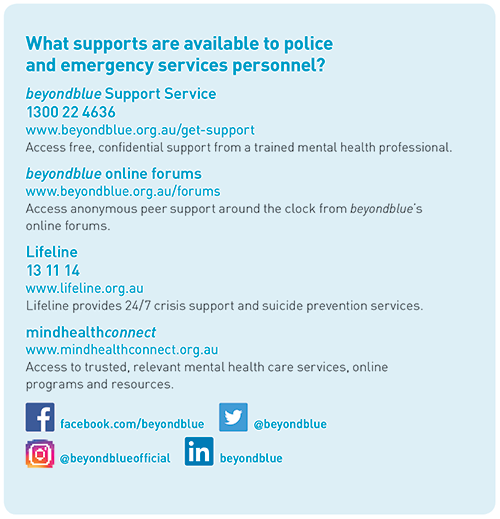
CFA’s capacity to mobilise
By Andrew Ford, VFBV Chief Executive Officer
February already! If you are like me, you will be wondering where the last few months have gone.
Naturally most people have been focussed on some demanding weather and fire situations and as we work our way through the summer fire season all efforts to date have demonstrated the great capacity of CFA and Victoria’s emergency sector to perform when the pressure is on.
CFA members should take heart in the fact that despite the current Government’s policy agenda to dismantle CFA, the community commentary has been one of appreciation and respect for the work CFA’s paid staff and volunteers do every day.
Like most summer periods, hot weather and high fire risk conditions plus first hand exposure to life threatening major fires for some, has prompted thankful recognition and constant public messages appreciating that Victoria’s capacity to deal with these major fires relies on CFA’s capacity to mobilise its huge, highly trained and professional volunteer resources whenever and wherever it is needed.
VEOHRC
Over the past weeks I have received many questions about what is happening to the Victorian Equal Opportunity and Human Rights Commission (VEOHRC) Independent Review into Equity and Diversity in CFA and MFB.
To recap, most people are aware that in 2017 the UFU instigated action in the Supreme Court seeking to prevent VEOHRC releasing its report publicly. The report was originally expected to be released mid 2017 but has been held up due to the UFU legal action. The Supreme Court provided a decision in early December 2017 dismissing the UFU application and confirming that the VEOHRC has acted within its powers in undertaking the work.
Following the Supreme Court dismissal of UFU’s application it was anticipated the VEOHRC report would be released sometime in January 2018, however in mid-January 2018 the UFU took further legal action appealing the Supreme Court decision in the Court of Appeal.
Subsequently the report has still not been released.
Our latest understanding is that the UFU’s appeal process continues and that VEOHRC is seeking to have this matter dealt with as quickly as possible.
The anxiety and frustration the delay is causing, particularly to people who participated in the review, is understood. VEOHRC is working through the UFU appeal process and a natural justice process to ensure any person whose reputation or rights may be adversely affected by a proposed adverse finding in the report is provided natural justice.
VFBV will continue to monitor the situation closely and hopefully the report is ready for release very soon.
I encourage anyone who needs support because of this delay to visit the VEOHRC website and follow the prompts to contact VEOHRC, seek support from our VFBV network and/or discuss your concerns with your local networks.
VFBV Volunteer Leadership Scholarship funding cut
On another matter I have also received many questions regarding the VFBV 2018 Volunteer Leadership Scholarship program. It frustrates me to say that this program has been cancelled for this year due to Government rejecting the VFBV funding bid which enabled the program to be offered to CFA volunteers and volunteers across the Victorian Emergency Sector.
VFBV received preliminary informal advice in late December 2017 that the funding for the Volunteer Leadership Scholarship was likely to be cut, and throughout January I have been seeking to convince Government officials to reconsider but have had no response. Whilst I am frustrated that there has not even been a formal advice to VFBV I do have to face the reality that the funding has been cut.
VFBV initiated this valuable volunteer leadership opportunity in 2010 and there have been 327 volunteer graduates over the eight years since the program commenced. VFBV developed and initiated the program fully funding it for many years and more recently expanding the number of CFA scholarships and offering scholarships to volunteers from SES, Coast Guard, Ambulance Victoria, Life Saving Victoria and St John through a combination of VFBV funds and a Victorian Government Valuing Volunteers Program(VVP) grant.
Despite the VFBV initiative receiving tremendous support and recognition from volunteers, agencies and members of the Ministerial Volunteer Consultative Forum and despite extremely positive support throughout this current VVP bidding and grants consideration process, the VFBV application was ultimately not supported at Ministerial level.
A combination of the Government cutting the funding for this project plus the late advice regarding funding rejection means that VFBV will not be able to run the full program nor even a scaled back program this year.
VFBV has enjoyed a long partnership with Chisholm Institute and we are now in discussions with them about how to approach future continuation of the program. VFBV will also be discussing alternative funding and fundraising strategies to ensure this program continues. Further information will be provided as soon as possible.
My apologies to all volunteers who had been anticipating the 2018 program. Formal notice will be sent to volunteers across other agencies in the coming days. I understand that the late cancellation notice will be disappointing for many, not the least being VFBV, Chisholm and our partners Emserv who all share a commitment to this program, however until now I have held off cancelling the 2018 program optimistically hoping that common sense would prevail and the funding would be approved.
Further information will be circulated to volunteers about how we work to encourage a rethink on the Government’s rejection of this important VFBV funding bid and also on the disappointing news that all VFBV 2018 Valuing Volunteer Program grant bids were rejected this year, apart from expanding our VFBV Welfare and Efficiency Survey to all Victorian emergency volunteers. Along with cutting the CFA funding to Fire Wise this does potentially signal an alarming trend.
BeyondBlue Survey
On page 11 in this edition of Fire Wise you will see an article promoting an important initiative being undertaken by BeyondBlue. The initiative, which involves a simple, totally anonymous survey, is seeking to improve mental health and wellbeing of emergency services personnel across Australia.
I fully support the work of Beyond Blue and encourage anyone who is contacted to participate with confidence that your details will be treated confidentially and that your input will be used genuinely to improve understanding and support for emergency service personnel, volunteer and paid staff alike.
This is an important and valuable BeyondBlue initiative and in addition I am pleased to advise that VFBV has commenced discussions with BeyondBlue to explore how we can build a close partnership to improve how we support our members in the areas of mental health and wellbeing. There will be more information regarding this to follow in future VFBV communications.
VFBV State Urban Junior Championships
Finally just a reminder for everyone to consider getting along to the VFBV State Urban Junior Championships to be held at Warrnambool on 24 and 25 February. Further details are provided elsewhere in Fire Wise.
Come and see tomorrow’s CFA volunteers proudly demonstrate their skills and if you are not involved with the CFA juniors program or haven’t witnessed the value the VFBV Junior Championships provide for young volunteers to develop practical skills and to be actively involved in CFA then get along and be inspired.
Scanner/listening set update
Due to the high number of changes including radio channel mapping and talk groups and fire ground channel reconfigurations across many Districts, CFA has agreed to a request by the VFBV/CFA Joint Communications & Technology Committee to provide a patch file that members can download and apply to their scanners.
This will save members having to manually update their sets. CFA Comms are working on the update file, and as soon as it is ready, we will let you know, and will also provide a copy for download on our website.
OUTAGE: On Thursday 7 December a small network configuration change to the Regional Radio Network was made by the network’s operator. One of these changes made use of a proprietary standard that is not part of the official P25 standard. This caused all Uniden Digital Scanners to fall silent, as they could not decode the stream. The cause of the issue was identified on Monday 11 December, and in discussions with CFA, CFA confirmed that it had requested an urgent rollback of the changes to the network that had been applied and it was expecting rollback to occur on the Tuesday.
On Tuesday 12 December, the changes were successfully rolled back, and services were all restored to normal. CFA has agreed to include a software update and bundle it with the previously mentioned patch file - that will include support for the propriety standard that was attempting to be rolled out. This will ensure scanners will not be affected by this problem again in the future. We will advise as soon as it is available.
Champs just weeks away
The State Urban Junior Championship will be conducted at Warrnambool over the weekend of 24 and 25 February 2018, with so far 68 teams from 45 brigades entered to compete including two teams from Kellerberrin, WA.
Altogether it is expected there will be up to 600 CFA junior members competing in the 18 events being held at Warrnambool.
VFBV reminds all Judges and Officials of the need for they to have applied for a Working With Children check prior to the Championships.
If not already organised, members can apply at workingwithchildren. vic.gov.au or to apply or update your details over the phone, please contact the VFBV office on 9886 1141.
Brigade Owned Vehicle Policy
The VFBV/CFA Joint Equipment & Infrastructure Committee continues to strongly advocate for implementation of changes to CFA’s Brigade Owned Vehicle Policies that were developed by a VFBV/CFA joint working party and endorsed by CFA several years ago.
The Committee believes the importance and reliance of Brigade Owned Vehicles and their impact and contribution on CFA’s operational capacity is not fully recognised or supported by current arrangements to the level commensurate with their vital importance and contribution to the State’s capacity.
The intent of the new policy was to provide greater support for Brigade Owned Vehicles, provide clarity and confidence in insurance coverage, streamlined registration processes as well as standardising maintenance arrangements and support subsidies which vary greatly across the State. The Committee has requested CFA advise of the new policies status and progress.
Vehicle Resource Tracking System Update
CFA has advised that the first batch of modems for installation into FCV’s has arrived, and fit has commenced to install the modems into nominated FCV’s. District OM’s have identified 439 vehicles across the State that will require installation, which involves adding an additional antenna and radio component to each vehicle. CFA has agreed to our request that fit out/installation technicians will visit each identified Brigade and carry out the works on-site. This ensures Brigades don’t have to drop off the vehicle anywhere and vehicles can remain in station and in service while the work is being performed. CFA have also confirmed that the works are fully funded by CFA at State level – and there will be no cost to Brigades.
The VFBV/CFA Joint Communications & Technology Committee has also reviewed CFA’s draft Resource Tracking Business Rule, and has provided feedback on the original version in October 2017, and additional feedback on a revised version on the 12th December. Members were generally comfortable with the proposed drafts, suggesting minor amendments to ensure: a requirement for CFA to advise all members on what will get tracked and how; inclusion in future new member and Induction programs so members are aware of what is reported; suggestions to ensure the data is maintained securely and safeguards in place to ensure the data is not misused; and explicit protections and safeguards in the business rule to protect members privacy and ensure that the data cannot be collected or used for disciplinary purposes. CFA has advised that it has supported and incorporated this feedback into its final version which it is expecting to submit to the CFA Executive Leadership for approval. CFA is hopeful that with roll-out and installation progressing on schedule, it will have an opportunity to start trialling the new resource tracking capability over the course of the current fire season.
beyondblue - Answering the Call - National Study

Have your say on the mental health of police and emergency services.
Even the most resilient police and emergency services worker and volunteer can be affected by the stress and trauma. That's why VFBV is supporting Answering the call - beyondblue's National Survey of Mental Health and Wellbeing of Police and Emergency Services Personnel.
We are working with beyondblue and CFA on a world-first national study to provide clear evidence about the issues affecting the mental health of police and emergency services personnel and identify the best ways to provide support.
Employees, volunteers and former employees from police, fire and rescue, ambulance and emergency services across Australia are being invited to participate in a short survey. In Victoria, VFBV has strongly advocated and supported CFA to be involved, and volunteers were sent invitations to participate in early February. If you receive an invitation we encourage you to participate.
beyondblue and VFBV are committed to working with organisations in the police and emergency services sector to ensure the survey results are used to improve the mental health and wellbeing of police and emergency services personnel.
The survey is completely voluntary and anonymous. Agencies will not see anyone's individual responses, as the online survey is being hosted by independent research organisation, Roy Morgan Research, and analysed independently by The University of Western Australia. No individual responses will be provided to CFA or VFBV.
A representative random sample of CFA volunteers is being invited to participate in the survey. Participants have been selected at random and not on the basis of their wellbeing. This is to provide a representation of the needs of the whole police and emergency services sector. If you were randomly selected, you will have received an email at the email address recorded on CFA's RMS system. For further information on the survey, please visit beyondblue.org.au/pesresearch and click on the 'FAQ's for participants' link. You can also phone the research team on 1800 677 248 or email This email address is being protected from spambots. You need JavaScript enabled to view it.
Don't miss out on having your say! Check your email to start the survey.
For more information visit this article on the VFBV website.
Training incidents safety reminder
Each quarter, the VFBV/ CFA Joint HR, Welfare and OH&S Committee monitors current injury and safety reports for trends.
Last quarter the Committee studied reported training incidents and near miss trends across regions and by the primary causations.
Injuries and near misses during training activities remains CFA’s highest reported injury activity. Training injury trends involve injuries to members’ knees, backs, fingers and legs. These injuries typically involve the impacts and/or contributing factors such as: Sprains/Stains, Handling of Hose lines and Branches, Slips, Trips & Falls, and Breathing apparatus drills.
The use of hose lines and branches is the most common piece of equipment involved which includes injuries from bowling hose resulting in being struck by the coupling or the branch when the line is charged. Approximately 62% of reporting training related incidents do not occur at training campuses but at localised less formal activities. CFA advise the training department are progressively working on improvements to raise awareness of training risks and training protocols.
On behalf of the Committee, members are reminded to perform dynamic risk assessments of all planned training activities, and encourage Brigades to appoint dedicated safety officers during activities to maintain a focus on safety during exercises. Pre training briefings to explain common injuries and preventions are highly effective at ensuring all activities maintain an active focus on safety. Thinking about safety isn’t just for those that organise training. Think about it when you are participating in it. Think about what you can do to ensure your activities and actions are safe – not just to you, but those around you. If you see something that isn’t right, or could be dangerous – speak up. It’s everyone’s responsibility.
2018 Brigade Delegate Development Program
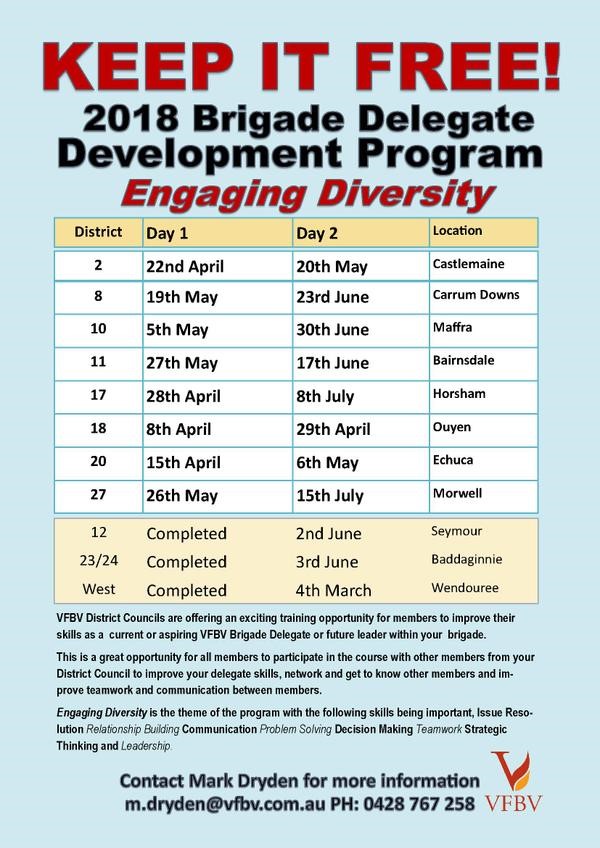
beyondblue - Answering the call - National Study
Written by Adam BarnettHave your say on the mental health of police and emergency services
The world’s largest study on mental health across emergency services personnel is happening right here, right now.
Some of you have been invited to participate, with the aim of the beyondblue Answering the Call survey to collect invaluable information about the issues affecting the mental health and wellbeing of police and emergency services personnel.
The data will give beyondblue the evidence it needs to determine the best ways to provide support.
The survey investigates the prevalence of common mental health conditions such as anxiety and depression, as well as post-traumatic stress disorder and suicide risk.
It will also collect important information about stigma, use of support services and programs, and factors that impact on the mental health of police and emergency services personnel.
Since October 2017, about 100,000 current and former employees and volunteers in police and emergency services agencies across Australia have been invited to participate.
Even the most resilient police and emergency services worker and volunteer can be affected by stress and trauma. That’s why VFBV is supporting Answering the call – beyondblue’s National Survey of Mental Health and Wellbeing of Police and Emergency Services Personnel.
We are working with beyondblue and CFA on a world-first national study to provide clear evidence about the issues affecting the mental health of police and emergency services personnel and identify the best ways to provide support.

Employees, volunteers and former employees from police, fire and rescue, ambulance and emergency services across Australia are being invited to participate in a short survey. In Victoria, VFBV has strongly advocated and supported CFA to be involved, and volunteers were sent invitations to participate on Friday 2nd February 2018. If you receive an invitation we encourage you to participate.
beyondblue and VFBV is committed to working with organisations in the police and emergency services sector to ensure the survey results are used to improve the mental health and wellbeing of police and emergency services personnel.
The survey is completely voluntary and anonymous. Agencies will not see anyone’s individual responses, as the online survey is being hosted by independent research organisation, Roy Morgan Research, and analysed independently by The University of Western Australia. No individual responses will be provided to CFA or VFBV.
A representative random sample of CFA volunteers is being invited to participate in the survey. Participants have been selected at random and not on the basis of their wellbeing. This is to provide a representation of the needs of the whole police and emergency services sector. If you were randomly selected, you will have received an email at the email address recorded on CFA’s RMS system. For further information on the survey, please visit beyondblue.org.au/pesresearch and click on the ‘FAQs for participants’ link. You can also phone the research team on 1800 677 248 or email This email address is being protected from spambots. You need JavaScript enabled to view it.
Don’t miss out on having your say! Check your email to start the survey. Double check your SPAM or JUNK folders to see if you received it. The invitation were emailed on Friday 2nd February, and would have been sent from this address: (Beyond Blue PE Survey) This email address is being protected from spambots. You need JavaScript enabled to view it.
A Frequently Asked Questions document can be found here
National Mental Health and Wellbeing Study of Police and Emergency Services
Project Overview
beyondblue is currently undertaking the National Mental Health and Wellbeing Study of Police and Emergency Services (Study). The Study aims to improve the mental health and wellbeing of police and emergency services personnel and reduce their risk of suicide by identifying evidence-based strategies focused on change at individual, organisational and systems levels. The findings of the completed Study will be used to inform the work of the beyondblue PES Program and influence policy and practice within police and emergency services and among governments responsible for these frontline services.
Rationale for the Study
Existing prevalence research on police and emergency services workforces in countries outside Australia shows that police and emergency services employees have higher rates of stress, depression, anxiety and PTSD, when compared with the general population. Research comparing police and emergency services’ suicide rates with general population suicide rates varies widely in its findings.
In Australia, a range of studies have been conducted to establish prevalence data and environmental data. Australian research has generally focused on a single population group (e.g. police officers in one agency), or issue (e.g. PTSD among fire-fighters in a given State). There is a lack of robust prevalence data examining the full range of common mental health issues and the spectrum of suicide risk (e.g. ideation, suicide attempts) experienced by police and emergency services personnel, including issues of co-morbidity of mental health conditions, and mental health conditions with substance misuse and physical health. Nor do we know which police and emergency services personnel are at greatest risk of experiencing a mental health condition or of experiencing suicidality or dying by suicide. There is also a dearth of data on the knowledge, attitudinal and behavioural factors of police and emergency services personnel that influence help-seeking for mental health conditions and that enables associations to be drawn about the individual, organisational and systems level risk and protective factors for mental health conditions and suicide. Measures of mental wellbeing are also lacking, and little is known about the influence of, and impact on, personal relationships and families.
The lack of appropriate data makes it difficult to understand the true nature of the mental health and wellbeing of this workforce (both serving and former), commonalities across and within specific cohorts, and the malleable factors that can be impacted on through appropriate interventions. These evidence gaps present critical risks for the development, implementation and evaluation of existing approaches within police and emergency services agencies that aim to improve mental health and reduce suicide risk among police and emergency services personnel.
There is a need for a comprehensive national dataset to establish essential baseline prevalence measures, individual knowledge, identify attitudinal and behavioural factors that influence help-seeking, and establish risk and protective factors for mental health, including the organisational policies and practices associated with mental health and suicide among police and emergency services personnel. This dataset is also required to design and develop appropriate interventions at an individual, organisational and systemic level.
The Study aims to fill this evidence gap in a way that ensures the police and emergency services sector is able to translate the research findings into practical actions that will lead to better mental health and decreased suicide risk for police and emergency services personnel in Australia.
The key components of the Study are:
- Mapping of existing research (complete)
- Advisory Group
- Phase 1: personal stories (complete)
- Phase 2: nationally representative survey
- Phase 3A: developing a knowledge translation plan
- Phase 3B: implementing the knowledge translation plan
Key components of the Study
Mapping of existing research The complex array of factors affecting the mental health of police and emergency services personnel, and long-standing recognition of the high-risk nature of their roles, means they are a heavily surveyed population. In order to ensure the Study fills existing knowledge gaps effectively, and avoids duplication and survey fatigue, beyondblue engaged Phoenix Australia to undertake a rapid mapping exercise of recent research relating to the mental health and suicide of police and emergency services personnel in Australia.
The mapping will be used to inform the approach to Phases 2 and 3 of the Study and enable beyondblue and the Study research team to more effectively engage with key researchers and agencies already contributing to the knowledge base in this field.
It should be noted a sizeable consultation process was undertaken to inform the design of the Study. This included interviews with 13 expert academics, 18 sector representatives, and 3 other stakeholders with relevant expertise, to seek advice on how to approach a range of aspects of the research such as the Study design, comparative datasets, target populations, stakeholder engagement, recruitment and administration, sampling, response rate, and knowledge translation. The three-phase Study design and all planned approach to the project have been shaped by this expert advice and influenced by beyondblue’s engagement with the police and emergency services sector.
Phase 1
Phase 1 was an exploratory qualitative Study designed to understand the experiences of current and former employees of police and emergency services, and their partners and families, in respect of factors that contribute to positive and negative mental health outcomes. Data gathered will inform the approach to the next phases of the Study, as well as provide a source of personal stories to facilitate engagement with the Study and the PES Program more broadly. This phase was undertaken by Whereto Research and completed in November 2016.
Advisory Group
beyondblue is committed to working collaboratively on the Study and ensure it is informed by the diversity and depth of expertise in the police and emergency services sector. An Advisory Group has been formed to provide strategic guidance for the Study. This group had its first meeting on 20 February 2017. The is chaired by Ken Lay AO APM, Chairman of Ambulance Victoria and former Chief Commissioner of Victoria Police, and includes representatives from agencies, unions and community groups, clinicians and academics, a former police officer and family member of an emergency services employee.
Phase 2
beyondblue has engaged The University of Western Australia and Roy Morgan Research to undertake Phase 2 of the Study which is a knowledge generation project involving a nationally representative cross-sectional survey of police and emergency services personnel in Australia.
The national survey will examine a broad range of issues relating to both the prevalence of wellbeing and the prevalence of common mental health conditions, help-seeking behaviours, and risk and protective factors in police and emergency services workplaces. This will form the bulk of the data collected for the Study.
The aim of Phase 2 of the Study is to establish a comprehensive understanding of the mental health and wellbeing of current police and emergency services personnel in Australia.
The objectives of this Phase are to:
- establish high-quality, national baseline measures for mental wellbeing, common mental health conditions, suicidality and associated substance use and/or physical health comorbidities in police and emergency services personnel;
- examine a broad range of risk and protective factors associated with mental health and mental illhealth among police and emergency services personnel in Australia;
- increase the evidence base on the influence of policies and practices aimed at promoting mental health and wellbeing among police and emergency services personnel; and
- identify the knowledge, attitudinal and behavioural factors that influence help-seeking for mental health conditions among police and emergency services personnel.
This phase of the Study will address the following research questions:
- What is the prevalance of mental wellbeing, common mental health conditions, suicidality and associated substance use and/or physical health comorbidities among police and emergency services personnel?;
- Are there any demographic, geographic or sector sub-groups at higher or lower risk of mental health conditions or suicidality?;
- What are the individual and organisational risk and protective factors associated with mental health and mental ill-health among police and emergency services personnel in Australia?; and,
- What are the individual knowledge, attitudinal and behavioural factors that influence help-seeking for mental health conditions among police and emergency services personnel?
A rigorous sampling strategy is critical for Phase 2 of the Study in order to increase the likelihood of achieving a representative sample. beyondblue’s preferred approach for Phase 2 is to adopt a stratified, random sampling strategy for selecting current police and emergency services personnel to participate. This approach aims to maximise the quality of the data gathered by allowing for identification of any possible biases within the sample and developing appropriate post-hoc analyses to control for these. It relies on systematic engagement with every single police and emergency services agency in Australia.
Volunteers and former police and emergency services personnel will be included in Phase 2, in order to fill long-standing knowledge gaps. Modified sampling strategies may be used in consideration of difficulties in accessing these cohorts. Due to the difficulty of accessing family members in a way that produces quality data, this group is not within scope for Phase 2 of the Study.
An important consideration for beyondblue is using survey measures that may be employed again in the future by police and emergency services agencies seeking to conduct further research in future years, to build upon the baseline measures established by this survey.
The Phase 2 survey will be administered online, with a limited number of hard copies available if requested. A comprehensive communications plan has been developing to secure executive support for the project within agencies, and drive participation among individual police and emergency services personnel. The survey will be branded with beyondblue’s logo and marks.
Phase 3
Phase 3 is a collaborative ‘evidence to action’ project intended to draw on a range of perspectives from the police and emergency services sector on how the findings from Phases 1 and 2 can best be translated into practical improvements in the mental health of police and emergency services personnel across Australia. This Phase is essential for the Study to provide real value and impact. This Phase has two sub-phases – 3A and 3B – which are described below.
The knowledge translation objectives of Phase 3 of the Study are to:
- work with the police and emergency services sector to identify the practical actions they can take to improve mental health and wellbeing in police and emergency services personnel;
- increase the capability of police and emergency services organisations to know how to effectively promote good mental health and reduce suicide risk in the police and emergency services workforce;
- guide change at individual, organisational and systems levels to improve the mental health of police and emergency services personnel and reduce their risk of suicide;
- develop mechanisms to support the ongoing monitoring and evaluation of these strategies; and
- provide a platform for beyondblue to advocate for improved programs and support to protect and promote the mental health of police and emergency services personnel and their families, and reduce their risk of suicide.
Detailed research questions are being developed for Phase 3 to explore the following key themes:
- What are stakeholders’ views on the implications of the findings from Phases 1 and 2 of the Study for police and emergency services agencies? What are the priorities for action?
- Drawing on the results of Phases 1 and 2, what are the most appropriate and effective ways to promote the mental health of current police and emergency services personnel through police and emergency services agencies and prevent the development of mental health conditions and suicide risk in police and emergency services personnel? How can those activities best be implemented in each organisation? What are the primary barriers and enabling factors for the implementation and impact of these activities and how can those be overcome or built upon? What are the critical factors for success? What is required to deliver on those strategies?
- What are the most appropriate and effective ways to support police and emergency services personnel who may be experiencing a mental health condition or suicide risk, and their families? How can those activities best be implemented in each organisation? What are the primary barriers to the implementation and impact of these activities and how can those barriers be overcome? What are the critical factors for success? What is required to deliver on those strategies?
- How should the proposed strategies for promotion, prevention and intervention be prioritised and by whom? Who should be responsible for co-ordinating efforts at the organisational and systems levels to implement these actions and how will they work in partnership with other police and emergency services stakeholders to achieve shared aims?
- What are the mechanisms that need to be put in place to support the ongoing routine monitoring and evaluation of the strategies identified by this Study? How will effectiveness be measured? Who will be responsible for implementing these mechanisms?
- What are the national indicators we should seek to monitor and how will this be done? How can the research instruments from Phase 2 of this Project be adapted and/or used by police and emergency services agencies seeking to measure the mental health and suicide risk of their workforces in the future?
Phase 3A: Developing a knowledge translation plan
beyondblue is seeking to apply best practice research methods to the Study and has engaged knowledge translation experts to lead the development of a knowledge translation, or ‘evidence to action’ plan for the Study. It is anticipated this plan will:
1. identify a broad range of goals, opportunities and activities which beyondblue and the police and emergency services sector could respond to, in order to translate the findings from Phases 1 and 2 of the Study, and other relevant research, into improved mental health and reduced suicide risk for police and emergency services personnel in Australia; and,
2. determine the core set of priority activities that will comprise Phase 3B of the Study and be undertaken by beyondblue and police and emergency services agencies and other key stakeholders.
Phase 3B: Implementing the knowledge translation plan
During Phase 3B, beyondblue and a dedicated team of researchers and other expert practitioners will support police and emergency services agencies and other key stakeholders to review the new evidence generated by the Study, and identify the best ways to respond. This will involve consulting with every agency regarding the findings of Phases 1 and 2 to figure out how to best interpret these findings, and apply them to meet the specific priorities and situation of each respective agency. Each agency operates within a unique context and the consultations will be informed by each organisation’s existing programs and services, specific needs, priorities, and network of partnerships and resources.
This stage of the Study aims to employ a collaborative, whole-of-sector approach to identify practical, evidence-based strategies to improve mental health and wellbeing within the individuals, organisations and systems that make up the Australian police and emergency services community. This will include agencies, unions and associations, insurers, regulators, relevant government departments, community and peer groups, individual employees and volunteers and family members.
For further information on the survey, please visit beyondblue.org.au/pesresearch and click on the ‘FAQs for participants’ link. You can also phone the research team on 1800 677 248 or email This email address is being protected from spambots. You need JavaScript enabled to view it.

More...
beyondblue - Answering the call - National Survey
Written by Adam BarnettHave your say on the mental health of police and emergency services
The world’s largest study on mental health across emergency services personnel is happening right here, right now.
Some of you have been invited to participate, with the aim of the beyondblue Answering the Call survey to collect invaluable information about the issues affecting the mental health and wellbeing of police and emergency services personnel.
The data will give beyondblue the evidence it needs to determine the best ways to provide support.
The survey investigates the prevalence of common mental health conditions such as anxiety and depression, as well as post-traumatic stress disorder and suicide risk.
It will also collect important information about stigma, use of support services and programs, and factors that impact on the mental health of police and emergency services personnel.
Since October 2017, about 100,000 current and former employees and volunteers in police and emergency services agencies across Australia have been invited to participate.
Even the most resilient police and emergency services worker and volunteer can be affected by stress and trauma. That’s why VFBV is supporting Answering the call – beyondblue’s National Survey of Mental Health and Wellbeing of Police and Emergency Services Personnel.
We are working with beyondblue and CFA on a world-first national study to provide clear evidence about the issues affecting the mental health of police and emergency services personnel and identify the best ways to provide support.

Employees, volunteers and former employees from police, fire and rescue, ambulance and emergency services across Australia are being invited to participate in a short survey. In Victoria, VFBV has strongly advocated and supported CFA to be involved, and volunteers were sent invitations to participate on Friday 2nd February 2018. If you receive an invitation we encourage you to participate.
beyondblue and VFBV is committed to working with organisations in the police and emergency services sector to ensure the survey results are used to improve the mental health and wellbeing of police and emergency services personnel.
The survey is completely voluntary and anonymous. Agencies will not see anyone’s individual responses, as the online survey is being hosted by independent research organisation, Roy Morgan Research, and analysed independently by The University of Western Australia. No individual responses will be provided to CFA or VFBV.
A representative random sample of CFA volunteers is being invited to participate in the survey. Participants have been selected at random and not on the basis of their wellbeing. This is to provide a representation of the needs of the whole police and emergency services sector. If you were randomly selected, you will have received an email at the email address recorded on CFA’s RMS system. For further information on the survey, please visit beyondblue.org.au/pesresearch and click on the ‘FAQs for participants’ link. You can also phone the research team on 1800 677 248 or email This email address is being protected from spambots. You need JavaScript enabled to view it.
Don’t miss out on having your say! Check your email to start the survey. Double check your SPAM or JUNK folders to see if you received it. The invitation were emailed on Friday 2nd February, and would have been sent from this address: (Beyond Blue PE Survey) This email address is being protected from spambots. You need JavaScript enabled to view it.
A Frequently Asked Questions document can be found here
National Mental Health and Wellbeing Study of Police and Emergency Services
Project Overview
beyondblue is currently undertaking the National Mental Health and Wellbeing Study of Police and Emergency Services (Study). The Study aims to improve the mental health and wellbeing of police and emergency services personnel and reduce their risk of suicide by identifying evidence-based strategies focused on change at individual, organisational and systems levels. The findings of the completed Study will be used to inform the work of the beyondblue PES Program and influence policy and practice within police and emergency services and among governments responsible for these frontline services.
Rationale for the Study
Existing prevalence research on police and emergency services workforces in countries outside Australia shows that police and emergency services employees have higher rates of stress, depression, anxiety and PTSD, when compared with the general population. Research comparing police and emergency services’ suicide rates with general population suicide rates varies widely in its findings.
In Australia, a range of studies have been conducted to establish prevalence data and environmental data. Australian research has generally focused on a single population group (e.g. police officers in one agency), or issue (e.g. PTSD among fire-fighters in a given State). There is a lack of robust prevalence data examining the full range of common mental health issues and the spectrum of suicide risk (e.g. ideation, suicide attempts) experienced by police and emergency services personnel, including issues of co-morbidity of mental health conditions, and mental health conditions with substance misuse and physical health. Nor do we know which police and emergency services personnel are at greatest risk of experiencing a mental health condition or of experiencing suicidality or dying by suicide. There is also a dearth of data on the knowledge, attitudinal and behavioural factors of police and emergency services personnel that influence help-seeking for mental health conditions and that enables associations to be drawn about the individual, organisational and systems level risk and protective factors for mental health conditions and suicide. Measures of mental wellbeing are also lacking, and little is known about the influence of, and impact on, personal relationships and families.
The lack of appropriate data makes it difficult to understand the true nature of the mental health and wellbeing of this workforce (both serving and former), commonalities across and within specific cohorts, and the malleable factors that can be impacted on through appropriate interventions. These evidence gaps present critical risks for the development, implementation and evaluation of existing approaches within police and emergency services agencies that aim to improve mental health and reduce suicide risk among police and emergency services personnel.
There is a need for a comprehensive national dataset to establish essential baseline prevalence measures, individual knowledge, identify attitudinal and behavioural factors that influence help-seeking, and establish risk and protective factors for mental health, including the organisational policies and practices associated with mental health and suicide among police and emergency services personnel. This dataset is also required to design and develop appropriate interventions at an individual, organisational and systemic level.
The Study aims to fill this evidence gap in a way that ensures the police and emergency services sector is able to translate the research findings into practical actions that will lead to better mental health and decreased suicide risk for police and emergency services personnel in Australia.
The key components of the Study are:
- Mapping of existing research (complete)
- Advisory Group
- Phase 1: personal stories (complete)
- Phase 2: nationally representative survey
- Phase 3A: developing a knowledge translation plan
- Phase 3B: implementing the knowledge translation plan
Key components of the Study
Mapping of existing research The complex array of factors affecting the mental health of police and emergency services personnel, and long-standing recognition of the high-risk nature of their roles, means they are a heavily surveyed population. In order to ensure the Study fills existing knowledge gaps effectively, and avoids duplication and survey fatigue, beyondblue engaged Phoenix Australia to undertake a rapid mapping exercise of recent research relating to the mental health and suicide of police and emergency services personnel in Australia.
The mapping will be used to inform the approach to Phases 2 and 3 of the Study and enable beyondblue and the Study research team to more effectively engage with key researchers and agencies already contributing to the knowledge base in this field.
It should be noted a sizeable consultation process was undertaken to inform the design of the Study. This included interviews with 13 expert academics, 18 sector representatives, and 3 other stakeholders with relevant expertise, to seek advice on how to approach a range of aspects of the research such as the Study design, comparative datasets, target populations, stakeholder engagement, recruitment and administration, sampling, response rate, and knowledge translation. The three-phase Study design and all planned approach to the project have been shaped by this expert advice and influenced by beyondblue’s engagement with the police and emergency services sector.
Phase 1
Phase 1 was an exploratory qualitative Study designed to understand the experiences of current and former employees of police and emergency services, and their partners and families, in respect of factors that contribute to positive and negative mental health outcomes. Data gathered will inform the approach to the next phases of the Study, as well as provide a source of personal stories to facilitate engagement with the Study and the PES Program more broadly. This phase was undertaken by Whereto Research and completed in November 2016.
Advisory Group
beyondblue is committed to working collaboratively on the Study and ensure it is informed by the diversity and depth of expertise in the police and emergency services sector. An Advisory Group has been formed to provide strategic guidance for the Study. This group had its first meeting on 20 February 2017. The is chaired by Ken Lay AO APM, Chairman of Ambulance Victoria and former Chief Commissioner of Victoria Police, and includes representatives from agencies, unions and community groups, clinicians and academics, a former police officer and family member of an emergency services employee.
Phase 2
beyondblue has engaged The University of Western Australia and Roy Morgan Research to undertake Phase 2 of the Study which is a knowledge generation project involving a nationally representative cross-sectional survey of police and emergency services personnel in Australia.
The national survey will examine a broad range of issues relating to both the prevalence of wellbeing and the prevalence of common mental health conditions, help-seeking behaviours, and risk and protective factors in police and emergency services workplaces. This will form the bulk of the data collected for the Study.
The aim of Phase 2 of the Study is to establish a comprehensive understanding of the mental health and wellbeing of current police and emergency services personnel in Australia.
The objectives of this Phase are to:
- establish high-quality, national baseline measures for mental wellbeing, common mental health conditions, suicidality and associated substance use and/or physical health comorbidities in police and emergency services personnel;
- examine a broad range of risk and protective factors associated with mental health and mental illhealth among police and emergency services personnel in Australia;
- increase the evidence base on the influence of policies and practices aimed at promoting mental health and wellbeing among police and emergency services personnel; and
- identify the knowledge, attitudinal and behavioural factors that influence help-seeking for mental health conditions among police and emergency services personnel.
This phase of the Study will address the following research questions:
- What is the prevalance of mental wellbeing, common mental health conditions, suicidality and associated substance use and/or physical health comorbidities among police and emergency services personnel?;
- Are there any demographic, geographic or sector sub-groups at higher or lower risk of mental health conditions or suicidality?;
- What are the individual and organisational risk and protective factors associated with mental health and mental ill-health among police and emergency services personnel in Australia?; and,
- What are the individual knowledge, attitudinal and behavioural factors that influence help-seeking for mental health conditions among police and emergency services personnel?
A rigorous sampling strategy is critical for Phase 2 of the Study in order to increase the likelihood of achieving a representative sample. beyondblue’s preferred approach for Phase 2 is to adopt a stratified, random sampling strategy for selecting current police and emergency services personnel to participate. This approach aims to maximise the quality of the data gathered by allowing for identification of any possible biases within the sample and developing appropriate post-hoc analyses to control for these. It relies on systematic engagement with every single police and emergency services agency in Australia.
Volunteers and former police and emergency services personnel will be included in Phase 2, in order to fill long-standing knowledge gaps. Modified sampling strategies may be used in consideration of difficulties in accessing these cohorts. Due to the difficulty of accessing family members in a way that produces quality data, this group is not within scope for Phase 2 of the Study.
An important consideration for beyondblue is using survey measures that may be employed again in the future by police and emergency services agencies seeking to conduct further research in future years, to build upon the baseline measures established by this survey.
The Phase 2 survey will be administered online, with a limited number of hard copies available if requested. A comprehensive communications plan has been developing to secure executive support for the project within agencies, and drive participation among individual police and emergency services personnel. The survey will be branded with beyondblue’s logo and marks.
Phase 3
Phase 3 is a collaborative ‘evidence to action’ project intended to draw on a range of perspectives from the police and emergency services sector on how the findings from Phases 1 and 2 can best be translated into practical improvements in the mental health of police and emergency services personnel across Australia. This Phase is essential for the Study to provide real value and impact. This Phase has two sub-phases – 3A and 3B – which are described below.
The knowledge translation objectives of Phase 3 of the Study are to:
- work with the police and emergency services sector to identify the practical actions they can take to improve mental health and wellbeing in police and emergency services personnel;
- increase the capability of police and emergency services organisations to know how to effectively promote good mental health and reduce suicide risk in the police and emergency services workforce;
- guide change at individual, organisational and systems levels to improve the mental health of police and emergency services personnel and reduce their risk of suicide;
- develop mechanisms to support the ongoing monitoring and evaluation of these strategies; and
- provide a platform for beyondblue to advocate for improved programs and support to protect and promote the mental health of police and emergency services personnel and their families, and reduce their risk of suicide.
Detailed research questions are being developed for Phase 3 to explore the following key themes:
- What are stakeholders’ views on the implications of the findings from Phases 1 and 2 of the Study for police and emergency services agencies? What are the priorities for action?
- Drawing on the results of Phases 1 and 2, what are the most appropriate and effective ways to promote the mental health of current police and emergency services personnel through police and emergency services agencies and prevent the development of mental health conditions and suicide risk in police and emergency services personnel? How can those activities best be implemented in each organisation? What are the primary barriers and enabling factors for the implementation and impact of these activities and how can those be overcome or built upon? What are the critical factors for success? What is required to deliver on those strategies?
- What are the most appropriate and effective ways to support police and emergency services personnel who may be experiencing a mental health condition or suicide risk, and their families? How can those activities best be implemented in each organisation? What are the primary barriers to the implementation and impact of these activities and how can those barriers be overcome? What are the critical factors for success? What is required to deliver on those strategies?
- How should the proposed strategies for promotion, prevention and intervention be prioritised and by whom? Who should be responsible for co-ordinating efforts at the organisational and systems levels to implement these actions and how will they work in partnership with other police and emergency services stakeholders to achieve shared aims?
- What are the mechanisms that need to be put in place to support the ongoing routine monitoring and evaluation of the strategies identified by this Study? How will effectiveness be measured? Who will be responsible for implementing these mechanisms?
- What are the national indicators we should seek to monitor and how will this be done? How can the research instruments from Phase 2 of this Project be adapted and/or used by police and emergency services agencies seeking to measure the mental health and suicide risk of their workforces in the future?
Phase 3A: Developing a knowledge translation plan
beyondblue is seeking to apply best practice research methods to the Study and has engaged knowledge translation experts to lead the development of a knowledge translation, or ‘evidence to action’ plan for the Study. It is anticipated this plan will:
1. identify a broad range of goals, opportunities and activities which beyondblue and the police and emergency services sector could respond to, in order to translate the findings from Phases 1 and 2 of the Study, and other relevant research, into improved mental health and reduced suicide risk for police and emergency services personnel in Australia; and,
2. determine the core set of priority activities that will comprise Phase 3B of the Study and be undertaken by beyondblue and police and emergency services agencies and other key stakeholders.
Phase 3B: Implementing the knowledge translation plan
During Phase 3B, beyondblue and a dedicated team of researchers and other expert practitioners will support police and emergency services agencies and other key stakeholders to review the new evidence generated by the Study, and identify the best ways to respond. This will involve consulting with every agency regarding the findings of Phases 1 and 2 to figure out how to best interpret these findings, and apply them to meet the specific priorities and situation of each respective agency. Each agency operates within a unique context and the consultations will be informed by each organisation’s existing programs and services, specific needs, priorities, and network of partnerships and resources.
This stage of the Study aims to employ a collaborative, whole-of-sector approach to identify practical, evidence-based strategies to improve mental health and wellbeing within the individuals, organisations and systems that make up the Australian police and emergency services community. This will include agencies, unions and associations, insurers, regulators, relevant government departments, community and peer groups, individual employees and volunteers and family members.
For further information on the survey, please visit beyondblue.org.au/pesresearch and click on the ‘FAQs for participants’ link. You can also phone the research team on 1800 677 248 or email This email address is being protected from spambots. You need JavaScript enabled to view it.

Welcome to a new year and a time for refreshed effort
By Andrew Ford, VFBV Chief Executive Officer
As I write this editorial we head into the New Year festivities and recover from our Christmas celebrations. Hopefully each of you have had a chance to relax (at least at some point) and enjoy Christmas with people you love or doing something you love.
We head into 2018 after an interesting 2017 to say the least and as always there are heaps of issues on the go and/or emerging. For now I want to focus on one key issue and that is welcoming the recently appointed CFA CEO Dr Paul Smith who will start work with CFA early in the New Year.
Since the formation of CFA, volunteers have welcomed many a new leader to the organisation. As those that have come before, Paul will become a key custodian of our proud organisations hopes and legacy. As volunteers, we have a proud record of embracing the new and looking positively to the future, knowing that it would take a very hard person indeed not to be touched by the wonderful community based organisation they are joining, I have no doubt that Paul’s commencement will mark a positive chapter in CFA’s long and proud history.
I personally look forward to a great collaborative relationship with Paul who brings a wealth of experience and from my networks a deserved reputation of being a values driven leader and person of high integrity. Paul has experience with CFA and the emergency sector and on behalf of all volunteers I say welcome and congratulations on your appointment Paul.
2017 VFBV Volunteer Welfare & Efficiency Survey – Interim Results
As you can see the main feature of this month’s page is a summary of the 2017 VFBV Welfare and Efficiency Survey and I encourage you to take time to understand the key results.
This year’s VFBV Volunteer Welfare & Efficiency survey closed at the end of October, with analysis now underway to compile this year’s full results. The final detailed report will be provided very soon, but in the meantime, we are providing some interim, high level results.
This year was the sixth consecutive year we have conducted the survey. We would like to the thank the 2,653 CFA participants who completed the survey this year. This is an outstanding result and the survey remains the largest survey of its kind within CFA and probably across the emergency sector, eclipsing other survey response rates by a significant margin.
This was also the second year in a row that VFBV has managed the survey Nationally for fire agencies across the country, and also the second year VFBV has managed the survey across the Victorian emergency volunteer sector, including 6 emergency management agencies across the state to give a Victorian emergency sector perspective. The annual survey broke a new record Nationally, with a total of 7,727 respondents across Australia. This represents the largest survey of emergency management volunteers across the country.
The VFBV Welfare and Efficiency survey is an important tool, used by us to work with CFA, government and key stakeholders to provide evidence based feedback on matters affecting the welfare and efficiency of CFA volunteers. The survey continues to be valuable in providing feedback on what is going well and where things can be improved.
Back in 2012, armed with only an idea - we workshopped the survey’s design and structure with volunteers across the State, running a number of facilitated workshops and focus groups. By the end of this process, we had feedback and representation from volunteers from every single CFA District across the State.
The survey was designed by and for volunteers, to better understand the issues as volunteers see them and to measure and understand how satisfied volunteers are with arrangements in place to support, encourage and enable them to do their work.
VFBV is extremely proud of the survey’s integrity and success, and we continue to devote considerable energy to the survey’s analysis, with the hope that CFA will continue to embrace the survey’s results and drive real improvement and tangible outcomes that directly address volunteers views and feedback.
The VFBV Welfare and Efficiency survey is making a difference and has certainly focussed attention of key policy and decision makers, sector leaders and volunteer support people to the issues seen as important to volunteers. The survey has been instrumental in shaping significant investment in a range of recently announced volunteer support, training and engagement initiatives.
One of the fundamental strengths of the survey is that it is a survey designed by and run by volunteers, providing an evidence based and unfiltered reflection of what volunteers are experiencing on the ground. As the name suggests, because the VFBV Welfare and Efficiency Survey is run by VFBV, it provides a volunteers assessment of how things are, rather than someone else’s assessment of what they think volunteers are experiencing.
It is VFBV’s legislated role to understand and bring to the attention of decision makers, issues affecting the welfare and efficiency of volunteers and this survey provides one of the most powerful tools for individual volunteers to communicate their assessment of how things are going to decision makers.
Thank you to everyone who participated in the survey this year and also in previous years. The old adage of ‘what gets measured gets done’ holds true and the ongoing trends now available from this survey will become an ever more valuable tool to influence areas requiring improvement and for identifying and sharing things that are working well.
VFBV will be running the survey again in 2018 so in addition to staying tuned for the detailed report, also make a note to participate again in the survey next year.
Thanks again to everyone involved.
2017 VFBV Volunteer Welfare and Efficiency Survey
Who participated
The VFBV Volunteer Welfare and Efficiency Survey, to the best of our knowledge, is now one of the largest volunteer surveys ever conducted. Participation is strengthened by the additional involvement of fire service volunteers in most States, the Victorian State Emergency Service Volunteer Association and other emergency management volunteer involving organisations in Victoria.
CFA Respondents
- 81% Male, 18% Female (nb: <1% indicated a different category).
- All age groups, roughly reflecting CFA’s age demographic, from long serving volunteers right through to those who’ve only been with the CFA for less than a year.
- Brigade Type:
- 63% volunteers with rural brigades
- 29% volunteers with urban brigades
- 7% volunteers with integrated brigades
- <1% volunteers with a CFA Coast Guard brigade
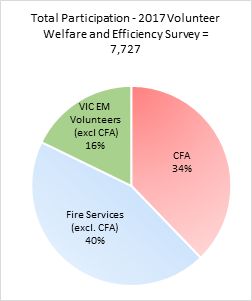
Interim Results: Initial Findings
- Volunteers are most satisfied, and expectations are closest to being met, at a local brigade level.
- Volunteers feel the time they devote to CFA is productive and worthwhile.
- Consultation with CFA volunteers at a Corporate and Regional level is where volunteer expectations are furthest from being met.
- Volunteers would like to see an improvement in the accessibility and flexibility of training, but this has improved slightly since last year.
- Acceptance of Diversity, no barriers to roles women can occupy within the brigade and a welcoming brigade are extremely important to CFA volunteers, and something they feel is done well.
- CFA’s policies, leadership and workforce arrangements which support an effective volunteer based and fully integrated organisation scored poorly, particularly by volunteers with integrated brigades.
- Recruitment and retention of younger volunteers continues to be seen as a challenge.
- Results for respondents who indicated they are members of rural brigades recorded the highest performance results in all themes.
- There is not a lot of difference in the results between the different genders, but females scored statements relating to brigade level slightly worse than males.
- Respondents identifying as volunteer members with integrated brigades recorded the lowest results across the themes, particularly in the theme “People Management – My Brigade”
- The only exception was in the area of Training, where respondents from urban brigades were less satisfied.
- The only exception was in the area of Training, where respondents from urban brigades were less satisfied.
- Respondents to the survey with less than one year of service were most satisfied. This satisfaction dropped significantly after one year, and then again after five years.
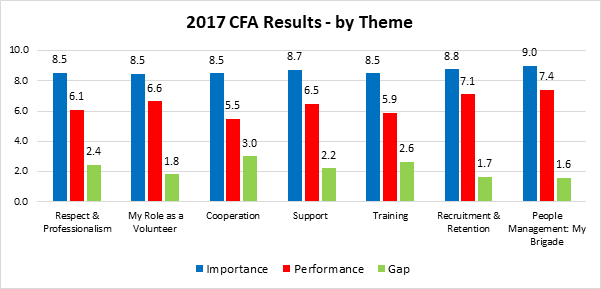
Interim Results: Satisfaction
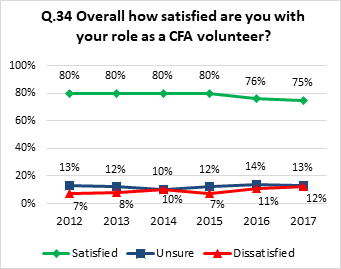
The overall number of volunteers satisfied with being a CFA volunteer continues to decline.
Volunteers with Integrated brigades are significantly less content with only 57% indicating they are satisfied. 78% of volunteers with rural brigades and 74% of volunteers with urban brigades indicated they are satisfied.
70% of volunteers who identified as brigade members are satisfied, compared to 79% who identified as being in leadership roles.
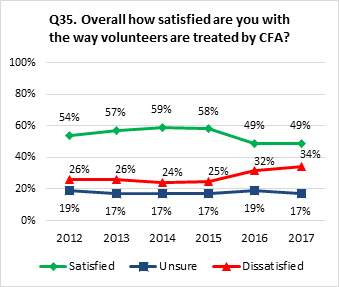
Satisfaction with the way volunteers are treated by CFA is showing no sign of improvement and is a figure that should be of significant concern to CFA.
Lower than the overall rating, only 42% of volunteers in broader leadership roles indicated they are satisfied.
59% of females compared to 46% of males are satisfied with the way they volunteers are treated by CFA.
Only 38% of volunteers who identified as members of integrated brigades indicated they are satisfied, with 43% indicating they are dissatisfied. Volunteers with rural brigades showed the highest satisfaction levels for this question with 53% indicating they are satisfied. The number of volunteers with urban brigades who indicated they are satisfied was 42%.
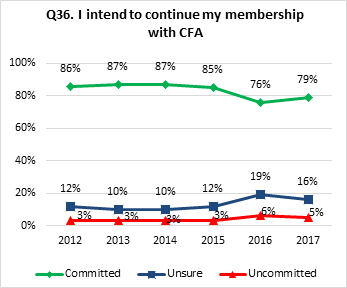
Overall, there has been a slight improvement in those intending to continue their membership with CFA, however the results reviewed by brigade type is important to be understood.
Only 60% of volunteers with integrated brigades indicated they intend to continue volunteerimg, down from 66% in 2016. This is in contrast with volunteers in rural brigades where 82% have indicated they intend to continue (up from 77% in 2016). The ratings for volunteers with urban brigades remains consistent with 2016 at 77%.
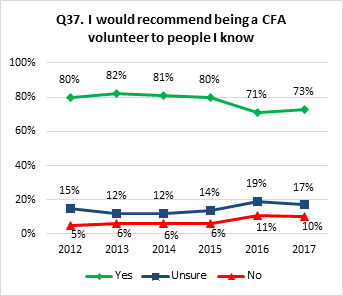
Overall another slightly improved result with an increase in the percentage of volunteers who would recommend being a CFA volunteer to others.
Again, the results of volunteers with integrated brigades being least satisfied is evident here. Only 50% of these volunteers indicated they would recommend being a CFA volunteer to others, this was 61% in 2016. Results for volunteers with rural brigades has increased to 77% now recommending being a CFA volunteer, compared with 73% in 2016. The results for volunteers with urban brigades remains steady at 70%.
Medium Tanker Survey Open
The Medium Tanker survey remains open, and volunteers are invited to provide feedback on the current Medium Tanker build.
An initiative of the Equipment & Infrastructure Committee - the purpose of the survey is to gather feedback from Brigades that have been issued with (or have familiarity with) the Medium Tankers and assess how the cab chassis, locker configuration and base equipment is operating, and if there are any areas of improvement that could be suggested for future builds.
The Committee is keen for feedback from any members who wish to provide their thoughts and experiences of how the Medium Tankers are working in the field.
If you have any feedback or design ideas that you think would benefit future builds – please get involved.
The survey can be found art the top of the VFBV website.
2017 VFBV Volunteer Welfare and Efficiency Survey Interim Results
Written by Adam BarnettNOTE TO MEMBERS – December 2017
Provided in this note to members are initial, high level results only. Further briefings on the results of the VFBV Volunteer Welfare and Efficiency Survey will be provided in the coming months and a detailed report will be published soon.
Background
The VFBV volunteer welfare and efficiency survey has now been conducted for the sixth consecutive year for CFA volunteers. The welfare and efficiency survey is an important tool, used by Volunteer Fire Brigades Victoria, to work with CFA, government and key stakeholders to provide evidence based feedback on matters affecting the welfare and efficiency of CFA volunteers. The survey continues to be valuable in providing feedback on what is going well and where things can be improved.
The survey was developed and introduced by VFBV in 2012. The survey was designed by and for volunteers, to better understand the issues as volunteers see them and to measure and understand how satisfied volunteers are with arrangements in place to support, encourage and enable them to do their work. Fundamental to the survey’s integrity and success is its facilitation and analysis undertaken by their volunteer association.
Who participated
There is very good engagement with the survey and beyond CFA, participation is strengthened by the additional involvement of fire service volunteers in most States, the Victorian State Emergency Service Volunteer Association and other emergency management volunteer involving organisations in Victoria.
CFA Respondents:
- The number of participants in 2017 remains high and provides statistically robust results representing volunteer views – 2653 CFA volunteers participated.
- 2017 had a higher percentage (18%) of female respondents compared to past surveys.
- There was good participation across all age groups, roughly reflecting CFAs age demographic.
- There was good representation from long serving volunteers right through to volunteers who have only been with the CFA for less than a year.
- Most participants (63%) said they are with rural brigades, the balance with urban (29%) or integrated brigades (7%). Less than 1% of those who responded indicated they were members of a CFA Coast Guard brigade.
- Most participants in the survey were either brigade members or leaders within their brigade, with 18% indicating they are in a broader leadership role beyond brigade level.
Preliminary Results: By Theme
33 Welfare and Efficiency Survey statements are grouped into 7 themes (see graph below). For each statement, participants provide a rating on the importance and performance on matters affecting volunteer welfare and efficiency. The size of the ‘gap’ between the two ratings is indicative of how closely volunteer expectations are being met (ie: the smaller the gap, the more closely volunteer expectations are to being met).
Results by theme are consistent with previous years, with no change to themes performing the best or worst.
- ‘People Management – My Brigade’ has the smallest gap of all themes.
- Cooperation across CFA’ has the largest gap of all themes.
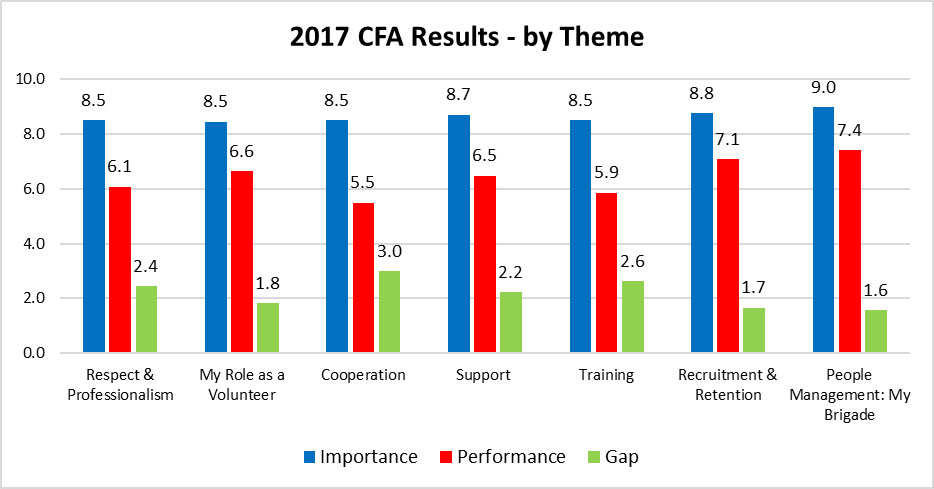
Respondents identified the best performing areas as those which related to matters primarily involving their volunteer activities at a local brigade level.
Respondents judged areas relating to CFA organisational support/management, particularly around consultation and training, as the poorest performing.
Whilst ‘Training’ was again judged as the one of the worst performing areas, results indicate a slight improvement in scores when compared to previous years.
- Results for respondents who indicated they are members of rural brigades showed the highest satisfaction in all themes.
- Results when separated by gender showed little difference. Overall, females tended to rate both importance and performance higher. In most cases, the male respondents’ cohort had slightly worse results than those from the female cohort. The exceptions were ‘Recruitment and Retention’ and ‘People Management’, where the statements were scored slightly worse by females. (nb: the additional gender categories of: transgender; prefer not to say; and, other, only totaled 1.1% of respondents and therefore do not have their results reported separately)
- Respondents identifying as volunteer members of integrated brigades rated performance in all themes the lowest, with the exception of Training.
- Training was rated lowest by volunteers with urban brigades when compared with volunteers from rural and integrated brigades.
- Whilst the theme ‘People Management – My Brigade’ is rated the best of all the themes overall, results for respondents identifying as volunteer members of integrated brigades showed significantly worse results in this area.
- Volunteers who participated in the survey and identified as having leadership roles at a level broader than their brigade tended to be less satisfied with the performance across the themes when compared with those who identified as brigade members or leaders within their brigades.
- The survey responses show that respondents with less than one year of service are most satisfied, but then there is a marked decrease in satisfaction recorded by those with between 1 and 5 years of service. There is a further drop in satisfaction recorded for those in the 6 to 10 years’ service group.
Preliminary Results: Survey Statements
Of the 33 statements in the survey, the below table represents those where volunteers’ expectations are closest to being met.
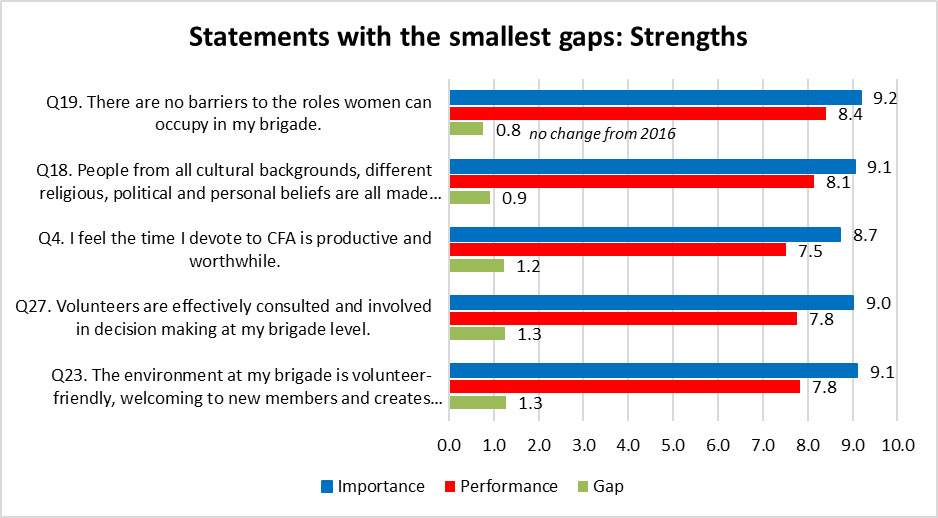
This is a very similar list to last year.
Of the 33 statements in the survey, the below table represents those where volunteers’ expectations are furthest from being met.
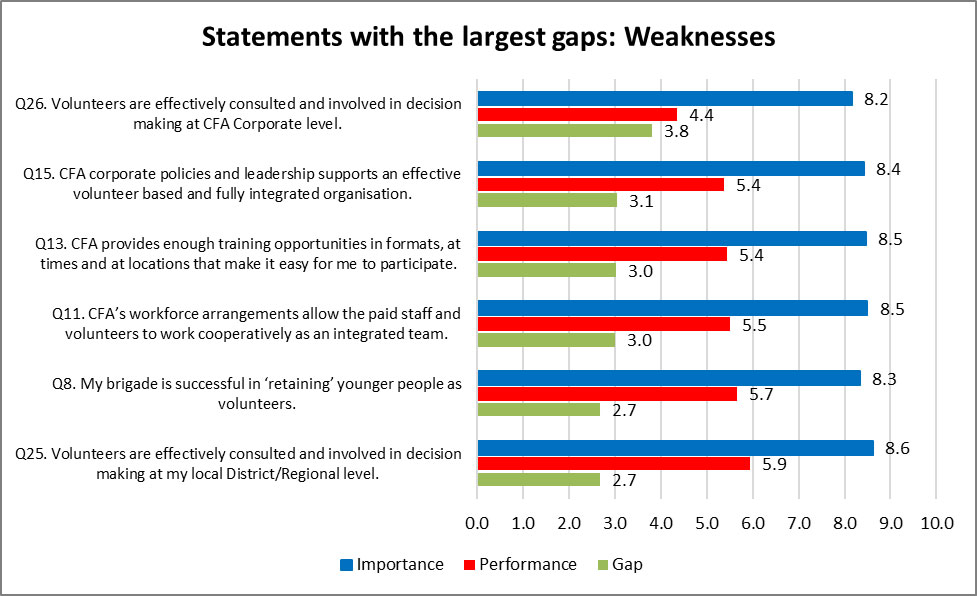
Whilst Q11 has improved slightly on last year, the ratings given by volunteers who identified as being members of integrated brigades worsened significantly.
Statements relating to recruiting and retaining younger volunteers both recorded ratings which indicate performance is declining in this area.
Preliminary Results: Satisfaction
The overall number of volunteers satisfied with being a CFA volunteer continues to decline.
Volunteers with Integrated brigades are significantly less content with only 57% indicating they are satisfied. 78% of volunteers with rural brigades and 74% of volunteers with urban brigades indicated they are satisfied.
70% of volunteers who identified as brigade members are satisfied, compared to 79% who identified as being in leadership roles.
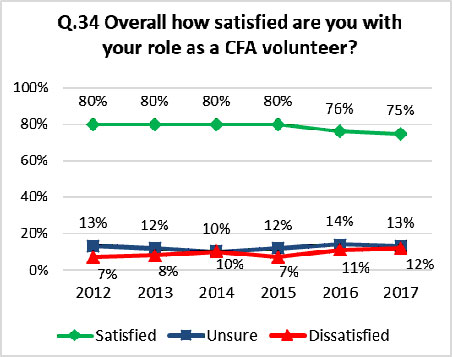
Satisfaction with the way volunteers are treated by CFA is showing no sign of improvement and is a figure that should be of significant concern to CFA.
Lower than the overall rating, only 42% of volunteers in broader leadership roles indicated they are satisfied.
59% of females compared to 46% of males are satisfied with the way they volunteers are treated by CFA.
Only 38% of volunteers who identified as members of integrated brigades indicated they are satisfied, with 43% indicating they are dissatisfied. Volunteers with rural brigades showed the highest levels for this question with 53% indicating they are satisfied. The number of volunteers with urban brigades who indicated they are satisfied was 42%.
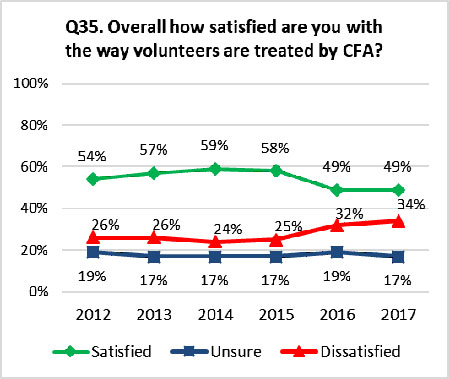
Overall, there has been a slight improvement in those intending to continue their membership with CFA, however the results reviewed by brigade type is important to be understood.
Only 60% of volunteers with integrated brigades indicated they intend to continue volunteers, down from 66% in 2016. This is in contrast with volunteers in rural brigades where 82% have indicated they intend to continue (up from 77% in 2016). The ratings for volunteers with urban brigades remains consistent with 2016 at 77%.
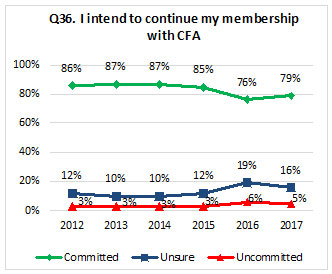
Overall another slightly improved result with an increase in the percentage of volunteers who would recommend being a CFA volunteer to others.
Again, the results of volunteers with integrated brigades being least satisfied is evident here. Only 50% of these volunteers indicated they would recommend being a CFA volunteer to others, this was 61% in 2016. Results for volunteers with rural brigades has increased to 77% now recommending being a CFA volunteer, compared with 73% in 2016. The results for volunteers with urban brigades remains steady at 70%.
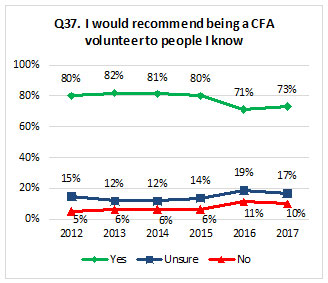
Message from the Victorian Equal Opportunity and Human Rights Commission
Written by Adam BarnettThe Victorian Equal Opportunity and Human Rights Commission has today released the following Statement:
Friday 15th December
Today the Supreme Court provided a decision in relation to the Independent Review into Equity and Diversity in CFA and MFB. The Court dismissed the application of the United Firefighters Union of Victoria and confirmed that the Commission acted within its powers in undertaking this work.
This decision means that we can publish the report of the Independent Review and that the voices of people who have spoken up will be heard. We know that this has been a long process which has had an impact on a number of people. Again, the Review thanks participants for their courage and patience in waiting for this outcome.
We will now undertake the few final steps required before publication. The Review is also required to ensure that any people or agencies specifically referred to have the opportunity to consider and respond to any comments in the report. While the Review will consider any responses provided during this process, final decisions in relation to the report content remain with the Commission.
Should you wish to speak with the Independent Review team, please contact This email address is being protected from spambots. You need JavaScript enabled to view it.';document.getElementById('cloakcf638bb78b205902b34512c0b413fd30').innerHTML += ''+addy_textcf638bb78b205902b34512c0b413fd30+'<\/a>'; or on 9032 3464. If today's court decision has raised any wellbeing issues we encourage you to access the support services available to participants: http://www.victorianhumanrightscommission.com/EDR/index.php/protecting-your-well-being
We look forward to publishing the report in January 2018.
 HomePage Featured
HomePage Featured